« December 2004 | Main | February 2005 »
January 31, 2005
Mail Art

Early Networked+Distributed Art
In an earlier post, telecommunications art pioneer Robert Adrian was quoted: "...it was Mail-Art with its concept of postal space - a blizzard of images circling the globe through the integrated postal services - that made it possible to conceive of artworks in the electronic space of the new networks." Here's Wikipedia's definition and history of Mail Art:
Mail art is art which uses the postal system as a medium. Mail art is also, simultaneously, a message that is sent, the medium through which it is sent as well as one of the longest-lasting art movements in history. To be precise, an amorphous international mail art network evolved of thousands of participants in over fifty countries between the 1950s and the 1990s from the work of Ray Johnson and influenced by earlier groups, including Dada, the Surrealists and Johnson's contemporaries in the Fluxus group. Mail artists characteristically exchange ephemera in the form of illustrated letters, zines, rubberstamped, decorated or illustrated envelopes, artist trading cards, postcards, 'artistamps', mail-interviews and three-dimensional objects.
Posted by jo at 12:46 PM | Comments (0)
RAW
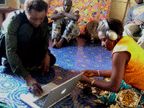
Capturing and Archiving Personal Artefacts
RAW--a project of the Human Connectedness group of the now defunct MediaLab Europe-- is a set of tools and processes for capturing, in an unconventional way, everyday subjective experience of a place, a culture, a people. RAW is named for the raw data gathered that purposefully remain unedited throughout the processes. The combined characteristics of RAW (including an emphasis on context of use, non-edition, and data presentation) make this concept a novel approach to authorship, to cultural exchanges, to audiovisual language, and to documentation.
At its core, RAW is an audiovisual recording device that combines a digital camera and audio recorder. Taking a picture triggers the recording of the sound a minute before and a minute after it. The relationship created between sound and image forms a disjoint flow and opens a new field of audiovisual expression. These previously uncaptured moments in time can be kept as personal artefacts and archived for human studies. The collected, unedited data will also be explored in a daring way within public interactive installations.
While RAW can address different intentions, its primary application is to be at the disposal of individuals in a series of social and cultural contexts. Specifically, its use in the African country of Mali has driven the research and development of the project.
Posted by jo at 12:20 PM | Comments (0)
The Horizon Report

Six Big Trends
The Horizon Report from New Media Centers is a annual project identifying key technologies that will inform teaching and learning in the next years. This year's edition highlights six areas: 1. Extended Learning 2. Ubiquitous Wireless 3. Intelligent Searching 4. Educational Gaming 5. Social Networks and Knowledge Webs 6. Context-Aware Computing/Augmented Reality.
The report includes a thorough discussion of each, plus links and other resources. Just a great resource. Go for it in PDF. [blogged by John on ratchet up!]
Posted by jo at 11:12 AM | Comments (0)
GPS::Tron

Classic Tron, Distributed
GPS::Tron, by Thomas Winkler, combines GPS, Bluetooth and GMS or GPRS with the classic Tron game concept--mobile phone plus computer game.
The players' movements in real space, which are tracked by GPS and transmitted to the phone's display, influence his/her position in the game. Each player is represented by a line that gets longer and longer. But the player's own line is never allowed to cross itself or the opponent's line. Which makes the game harder as time passes. The goal is to drive your opponent into a corner so that he can no longer extend his line without breaking the rules and losing. This is a game for two players who can be geographically distant from one another. [posted by Regine on near near future]
Posted by jo at 10:31 AM | Comments (0)
January 30, 2005
The first session with ADaPT Tokyo
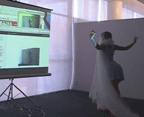
First Big Step in Japanese Dance World
In Japan, there has been few groundwork for media performance for years. However, there is few infrastructure in this field. I have been constructing interdisciplinary dance researchers' network inside Japan and Asia Pacific. I have started working for them since 2004. In the rehearsal of ADaPT Live Event Participating Performance Teams, a test session was held. A Japanese choreographer, Saeko, danced her piece "Veil," and Johannes Birringer and staffs at Nottingham (UK), and Kelly Gottesman at Wayne State University saw her dance image. I believe that it was a first big step in Japanese dance world. Related URLS: LATela: Live Art Telematics Lab: ADaPT also initiated the first transcontinental interface-performance between partners in the West and the Far East by Johannes Birringer; ADaPT Tokyo (Japan). [Posted by Yukihiko YOSHIDA]
Posted by jo at 01:14 PM | Comments (0)
January 28, 2005
Pete Gomes

Locative Performance
Peter Gomes, (parkbenchtv.org), uses GPS in Here, here and... here (2003) [Duration 40 mins DV Cam] A 40 minute performance/drawing at the ICA in in London.
The piece was made prior to, and was part of, a lecture on "Locative Media and Performance".
"Here, here and ..here" used a GPS to globally position the ICA and drew the information from the GPS screen onto the pavement in white chalk - mapping the ICA using 3D GPS Location and coordinates.
On either side of the drawn GPS screen are two other sections drawn in dotted lines. These show the variations of the coordinates on either side of the doorway, which suggest the infinite and ongoing grid of coordinates beyond this location.
The screen and drawing included; numbered satellites; position of satelites; accuracy; elevation; along with bars to show satellite strength, and a date, and time.
The seconds on the time, were the last thing to be written – giving a precise time, using an atomic clock, to mark the conclusion of the piece.
Posted by michelle at 12:19 PM | Comments (0)
wireless makes local connection

DIY Community Node:
Welcome to Park Bench TV!. A physical portal in Central London, a specific bench within clear range of a wireless internet signal...come down and log on.
This is a public bench in the middle of a quiet square London near Tottenham Court Road, –- where you can access the internet and tap into a local community of people, living and working in the area - and eat your lunch.
Find out more about the project and what its about. Come and sit on the bench with your laptop, and access the internet and see programmes about the local area - or just surf and pick up email.
Chat in the on line forum and discuss local issues or comment on the project
View video programmes using the Park Bench TV Channel
Make and add your own new programmes about the area to Park Bench TV
Find out about wireless internet technology and how to use it
Get on Park Bench TV and become a local celebrity!
The aim is to allow local people to access content about their immediate location and also begin to develop a way for visitors to gain an insight into our area.
This includes interviews with local people including the gardeners in the square, local residents, and other community figures.
If you want to appear on the channel and be interviewed, access the forum and ask us! We will be happy to meet you.
The wireless internet access point has been set up and specifically installed to allow access for users outside in the street, a local community and tourist service.
Open Access
How you can contribute..
The best place to ask detailed questions is the forum.
The channel will be using the Frequency Clock - a media player that allows us to organise video clips into a channel. and which will also allow users to upload and schedule their own material.
If you want to know how to contribute programme material and details about how to access it..
All of the content on the channel is focusing on the community, facilities, people, workers, and visitors to the area; tourists, lunchtime visitors, local gardeners and sometimes pigeons are the stars.
You can access the channel directly from the bench using a laptop and a WiFi card connected to the internet.
You can watch the content from the internet anywhere in the world – and if you want you can contribute to the channel – the only rule is that the content has to be about the area local to the bench and it's immediate surroundings.
As the content is all locally specific – and some of it will not always make sense or be understood when viewed from outside the benches immediate location.
So you might want to visit the bench and watch the channel from there – and maybe make some content, recording your stay with a cam corder, which you can then upload to the channel.
The channel will play the following file types : Real Player, Windows Media, Flash and Quicktime.
Join the forum and ask about what's going on - whether your in the area or not.
Posted by michelle at 11:39 AM | Comments (0)
January 27, 2005
Re-Place-ing Space:
The Roles of Place and Space in Collaborative Systems
ABSTRACT: Many collaborative and communicative environments use notions of "space" and spatial organisation to facilitate and structure interaction. We argue that a focus on spatial models is misplaced. Drawing on understandings from architecture and urban design, as well as from our own research findings, we highlight the critical distinction between "space" and "place'." While designers use spatial models to support interaction, we show how it is actually a notion of "place" which frames interactive behaviour. This leads us to re-evaluate spatial systems, and discuss how "place," rather than "space," can support CSCW design. [via clippings] Read full paper >>
Posted by jo at 05:52 PM | Comments (0)
Distributed Narrative:
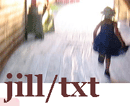
Telling Stories Across Networks
"Until recently, narratives have been constructed to achieve unity. While postmodern narratives open out into fragments and bricolage in content, plot and style, distributed narratives take this further, opening up the formal and physical aspects of the work and spreading themselves across time, space and the network. You see your first fragments of Implementation on stickers posted on signposts on your way to work and find the rest online when you google a remembered sentence. Surrender Control sends you text messages regardless of where you are or what you're doing..." From Distributed Narrative: Telling Stories Across Networks by Jill Walker.
Posted by jo at 05:29 PM | Comments (0)
Motivations for AR Gaming
T. Nilsen, S. Linton, J. Looser. Motivations for AR Gaming (.pdf). In Proceedings Fuse 04, New Zealand Game Developers Conference, Dunedin, New Zealand, 26-29 June 2004, pp 86-93.
In Augmented Reality (AR), interfaces consist of a blend of both real and virtual content. In this paper we examine existing gaming styles played in the real world or on computers. We discuss the strengths and weaknesses of these mediums within an informal model of gaming experience split into four aspects; physical, mental, social and emotional. We find that their strengths are mostly complementary, and argue that games built in AR can blend them to enhance existing game styles and open up new ones. To illustrate these ideas, we present our work on AR Worms, a re-implementation of the classic computer game Worms using Augmented Reality. We discuss how AR has enabled us to start exploring interfaces for gaming, and present informal observations of players at several demonstrations. Finally, we present some ideas for AR games in the area of strategy and role playing games. [via pasta and vinegar]
Posted by jo at 05:00 PM | Comments (0)
Mobile Metropolitan Ad hoc Networks

How to Recognize The Future When It Lands On You, Wireless Quilts
"The MobileMAN Project is a technological european research project that is part of the Framework Programme 5 - and more precisely of the Information Society Technologies group of activities. It aims at developing a communication network that is mobile and ad hoc - that is, which is entirely made of users' devices. In such network, users devices are not only the "clients", but they also act as "servers" and "routers". To summarize, they consume but also provide services. Collaboration places a key role in the system to work.
Claudia writes that there is a dedicated wiki on it and she would like to ask to come by, have a look and post some ideas, comments, suggestions, critics, whatever on this wiki." [blogged by Gerrit Visser smartmobs]
Posted by jo at 01:01 PM | Comments (0)
A Generation Lost in its Personal Space

Technology Faulted
After listening to Anne Galloway's marvelous lecture at Emerson College last night, this post by Jason Kottke seems particularly apt this morning:
"John Naughton writes in the Guardian about the loss of public social interaction. He places a lot of the blame on technology:
It's not clear when all of this changed, but my guess is that technology - in the shape of the Sony Walkman - had a lot to do with it. As the Walkman de nos jours, the iPod is simply continuing what Sony started. But not even Sony could have single-handedly destroyed the notion of social space. The coup de grce [sic] was administered by another piece of technology: the mobile phone.
Living in NYC, I'm well-positioned to observe the effect that mobile phones and iPods have on public interaction, but I would guess that the main factor in people not talking to each other on the street as much as they used to (in America at least) is cultural rather than technological. People move more often these days so they get to know less people in their neighborhoods. The decreasing costs of travel have filled urban streets with non-locals. "Don't talk to strangers" is the prevailing attitude; we teach our children that strangers are to be feared. Living in the suburbs and heavy automobile usage have made Americans unaccustomed to casual conversation with strangers...we're out of practice. Life moves a lot faster than it used to as well. We don't have time for casual conversations with strangers anymore; our time is reserved for working, sleeping, interacting with people we already know (family, co-workers, friends, the gang at the bar), and getting to and from places where we do those things as quickly as possible.
The mobile phone, Sony Walkman, and iPod fit comfortably into that type of culture, but I don't think they're driving it. If any technology is to blame, I'd choose the automobile, the suburb, and the television over the three Naughton mentions."
Posted by jo at 10:51 AM | Comments (0)
East by West
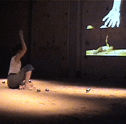
Fictional Geographies and Mediated Presences
"The concept of networked, translocal spaces allows investigation of the nature of real-time sound synthesis and how extended physical space can be shared by people when they play with fictional geographies, strange or familiar objects, and their mediated presences. Telepresence restructures and enlarges the environment with its projection (window) of mediated and combined presences in action. Linking a "local" site with a "remote" site raises particular challenges for our understanding of new artistic paradigms in telepresence, distributed and "navigational" art. The social orientation toward sensual environments and "hyperplasticity" is not directed at euphoric assumptions about virtual reality (VR) but at concrete, synaesthetic processes of cognition. East by West addresses the visitors' playful fantasy and tactile exploration of the environment; the interface becomes useful. If such play recognizes how parallel reality-systems can converge or affect each other, how we integrate other realities into our social experience."
Posted by jo at 09:44 AM | Comments (0)
Here I come again (Flying Birdman)

Between Sites and Non-Sites
Here I come again (Flying Birdman) was a telematic "earthwork" - an earthwork dance linking five remote sites in the United States with two locations in Brazil. It was based on narratives/dreams and structured spirally as a "Renga" (the old Japanese form of a linked poem) composed of live dance; real-time audio and sound processing, pre-recorded filmic images; still images, and both spoken voice and graphic text communication exchanged by participants during the live performance.
Thematically, the performances delved into "left overs," debris, decomposing sites, dumps, and the idea of re-cycling of landfills: what is returned needs to be transported from one site to another. The dramaturgy for this telematic "earthwork'" envisioned a spiraling dialogue/communication -between sites and "non-sites"- with at least 2 sites dialoguing with each other (video, audio) at any given time during the 10 scenes. The dialogue was passed on and moved around, as in the Renga for of a linked poem. The online viewer was invited to follow the spiral. View movies >>
Posted by jo at 08:56 AM | Comments (0)
January 26, 2005
The Dream Project

Reinforcing the Disparity Between Virtuality and Physicality
In the teleconference performance The Dream Project--by Keith Roberson and Company in Space--performers wearing datasuits control virtual avatars in a shared virtual reality environment. Bridging the gap between multiple locations, these avatars interact with each other. Their interactions explore possibilities beyond the physical body. Choreography of these virtual bodies, based on Quantum and Super-string theory, reinforces the disparity between virtuality and physicality.
Posted by jo at 11:13 AM | Comments (0)
Documenta 6 Satellite Telecast
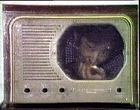
An Homage to Global Communications
Documenta 6 Satellite Telecast, by Joseph Beuys, Douglas Davis, and Nam June Paik; Video; 30 min, color, sound, 1977. Available at Electronic Arts Intermix:
"In 1977, Documenta 6 featured the first live international satellite telecast by artists. Performances by Nam June Paik, German conceptual artist Joseph Beuys, and Douglas Davis were transmitted to over twenty-five countries. Paik and Charlotte Moorman are seen live from Kassel in Fluxus-inspired collaborative performances, including TV Bra, TV Cello, and TV Bed. They fuse music, performance, video and television in an homage to global communications. Also from Kassel, Joseph Beuys presents a direct address to the public, elaborating on his utopian theories of art as "social sculpture," which were crucial to his conceptual project. From Caracas, Venezuela, Davis performs The Last Nine Minutes, a participatory piece in which he addresses the time/space distance between himself and the television viewing audience."
Posted by jo at 11:12 AM | Comments (0)
Microwave Boombox

Tools for radio waves hunters
Third part of part of Strangely Familiar. Unusual Objects for Everyday Life. Oren Horev, Myriel Milicevic (who had worked also on the Zone project) and Marcos Weskamp designed the Amazing All-Band Radio, three innocent-looking devices that allow users to hunt short, medium and long radio waves from the comfort of their home.
The antenna of the Microwave Boombox captures the high-frequency signals of wireless communication devices and translates them into sound. Radio Radio tunes into different wavelengths physically, by extending the string-antenna. The longer the string the higher the wave frequency. Cosmic Radio looks for long waves signals that reach us from the stars and the depths of the earth (above left). [blogged by Regine on we-make-money-not]
Posted by jo at 10:22 AM | Comments (0)
January 25, 2005
GoingPublik
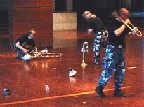
Mobile Multimedia as Mixed Reality
GoingPublik is a sound art work for distributive ensemble and mobile score synthesis. The core idea behind the work is a strategy of mobility by employing a wearable computer system running a software based electronic scoring system. GoingPublik will be performed at Interactive Futures 05 on February 5 from 9:30-10:30 pm. Art Clay will present a lecture "GoingPublik: Mobile Multimedia as Mixed Reality" from 2:30-3:30 PM.
"The core idea in the project is a strategy of mobility and this is accomplished employing a wearable computer system running the software based electronic scoring system as its central element. The program itself basically allows for what might be termed 'composed improvisation' which permits improvisational elements within a compositional structure. This is accomplished by electronically monitoring the performer's physical behaviour during performance. The program then responds by making suggestions to and even demands on the performer to various degrees and at various times.
Since each of the performers is equipped with the same electronic scoring system and because the system revolves around universally shared inputs such as geographical positions obtained via satellites and sensors using the earth's magnetic field, all have a common denominator and are thereby virtually linked. Despite the physical distribution of the performers in space, it is possible to have a commonly shared compositional palette and, at moments of close proximity between performers, to obtain instantaneous synchronized sonic elements. Both aspects needed for creating sonic structure within the work." Read paper >>
Composition Camouflaged: On the Relationship between Interpretation and Improvisation; Interview with Roland Dahinden, Günter Heinz & Thierry Madiot on the World Premiere of GoingPublik by Franziska Martinsen
Posted by jo at 10:05 AM | Comments (0)
Floating Points 2

Networked Art in Public Spaces
"I'm heading to Boston later today because I've been generously invited to present tomorrow night's introductory lecture for the Floating Points 2 speaker series on networked art in public spaces at Emerson College. Here is my presentation abstract, and for those who can't make it in person - it's free and open to the public - my talk will be streamed live at 7pm EST.
PLAYFUL MOBILITIES: Mobile phone usage is already commonplace for many people around the world, and other wireless technologies promise to become just as pervasive in coming decades. As technological development continues apace, scholars and artists have begun in earnest to explore the social and cultural implications of our emerging devices. Mobile and networked computing has the potential to cultivate new opportunities for personal autonomy and collective action, as well as to re-inscribe existing social inequalities and discourage cultural diversity. Bringing together theory, art and technology to critique - and create – these shared spaces is nothing new, but it takes on increasing value and importance as we struggle to negotiate between private and public interests in our technologically saturated daily lives. This presentation will consider what is at stake in these relationships, and what play and creativity can offer in terms of critical approaches to mobility." [via Anne Galloway]
Posted by jo at 09:33 AM | Comments (0)
In Conversation
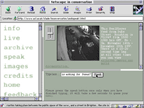
From Street to Chatroom
When live and located, In Conversation provided the means for individuals in the street and on the Internet to engage in a live dialogue with each other. This work by British artist Susan Collins aimed to examine the boundaries and social customs of distinctly different kinds of public spaces - the street and the Internet/chatroom-each with its own established rules of engagement.
Passers-by encountered an animated mouth projected onto the pavement and, through loudspeakers, could hear voices triggered by internet users trying to strike up a conversation. When the pedestrians responded, a concealed microphone and surveillance camera transmitted the responses to the website via a live video stream (webcast). Through the website, online visitors could view the surveillance video and hear the people on the street. They could type messages and send them 'live' to the installation where they were converted into speech and broadcast to the street through loudspeakers.
Posted by jo at 09:08 AM | Comments (0)
January 24, 2005
painterly surveillance techniques
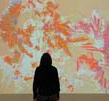
aesthetic system
Camille Utterback's interactive installation
Untitled 5 is the fifth interactive installation in the External Measures Series, which Utterback has been developing since 2001. The goal of these works is to create an aesthetic system which responds fluidly and intriguingly to physical movement in the exhibit space. The installations respond to their environment via input from an overhead video camera. Custom video tracking and drawing software outputs a changing wall projection in response to the activities in the space. The existence, positions, and behaviors of various parts of the projected image depend entirely on people's presence and movement in the exhibit area.
Untitled 5 creates imagery that is painterly, organic, and evocative while still being completely algorithmic. To create this work, Utterback first develops sets of animated marks whose parameters and behaviors are controlled by people's movements. Then, out of a working 'palette' of these animated marks, she composes an overall composition. The composition balances responses whose logic is immediately clear, with responses that feel connected to viewer's movements, but whose logic remains complex and mysterious.
Integral to the piece are the animated mark's cumulative interaction with each other over time. As a person moves through the space, a colored line maps his or her trajectory across the projection. When a person leaves the installation, their trajectory line is transformed by an overlay of tiny organic marks. These marks can now be pushed from their location by other people's movement in the space. Displaced trajectory marks attempt to return to their original location, creating smears and streaks of color as they move. The resulting swaths of color occur at the intersections between current and previous motion in the space, elegantly connecting different moments of time. This is just one of the behavioral elements of the composition.
While the specific rules of the system are never explicitly revealed to participants, the internal structure and composition of the piece can be discovered through a process of kinesthetic exploration. Engaging with this work creates a visceral sense of unfolding or revelation, but also a feeling of immediacy and loss. The experience of this work is the experience of embodied existence itself - a continual flow of unique and fleeting moments. The effect is at once sensual and contemplative.
Posted by michelle at 07:21 PM | Comments (0)
true look

networked performance
Isabelle Jenniches true looks takes over a store's webcam system, intended as a marketing ploy for online clients to check out their collection of smart Italian furniture. The artist's friends and colleagues -dancer, cook, choir member -are sent into the furniture store located in SoHo (NYC) as covert protagonists. Mingling with the clients, shop assistants and teamsters they are instructed to initiate subtle dramatic occurrences amidst the beds and sofas. Everyday patterns of consumer behavior are being poached, subverted into micro-dramatic moments which are followed and captured using the store's robotic webcam system. A selection of these images distills the routines and surprises of daily life in the shop into a series of episodes -part photo novella, part documentary -with text by theatermaker Richard Foreman.
Posted by michelle at 07:09 PM | Comments (0)
book on topic
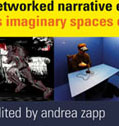
networked narrative
Andrea Zapp edits Networked Narrative Environments. Via various forms of audio-visual communications, from chat protocols, net and software art to online theatre and immersive telepresence, artists are using a wide range of technologies to explore the digital network as a narrative space. Human presence is increasingly subject to a constant flow of online contributions, material, and data. How does this reposition our collective understanding of the physical and the virtual, the real and the imaginary?
In this context the 'networked narrative environment' must be defined as an artistic modus operandi and experiment that reflects medial and social processes. The book documents exemplary and unique research positions within a developing genre. It serves as a resourceful illustration of the cultural debate on narratives, networking, and media art.
Leading international artists, writers, and curators examine specific examples of public installations and dramatic spaces that are linked to the Internet with the aim to integrate the viewer into the artwork. Key artistic projects and initiatives reflect sophisticated and complex new models of audience participation, real-time experience, and production of content:
Posted by michelle at 06:41 PM | Comments (0)
artificial changelings

Sphere of Influence
In Toni Dove's Artificial Changelings there is the possibility of moving back and forth between two centuries as if they were parallel realities suspended in a universe where time has no linear direction. The viewer does not change the narrative events, but develops a more immersive relationship with the characters and environment based on physical behavior. Different viewer responses will produce different aspects of content, emotional tone and information.
Posted by michelle at 06:26 PM | Comments (0)
immersence

Still Powerful
Fusing art and technology, Char Davies has achieved international recognition for her work in virtual reality. Integrating real-time stereoscopic 3-D computer graphics, 3-D localized sound and user interaction based on breath & balance, the immersive environments Osmose (1995) and Ephémère (1998) are world-renowned for their artistic sensibility, technical innovation, and powerful effect on participants.
Posted by michelle at 06:03 PM | Comments (0)
Digital Shelters
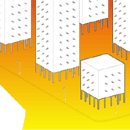
Scanscapes
A new landscape is emerging in the urban space, a SCANSCAPE that transgresses the boundaries and protocols of public and private space due to the extensive use of surveillance apparatus and telecommunication systems in the urban realm. How can we define these Scanscapes? How can we create Digital Shelters that will protect us, isolate us or allow us to live within these Scanscapes?
Digital Shelters, a PhD project by Pedro Sepulveda, explores how critical responses to the surveillance apparatus and telecommunication systems in the city landscape can inform the development of aesthetic possibilities for electronic spaces.
Posted by jo at 04:29 PM | Comments (0)
Binary Ballistic Ballet

Silent Virtual Dancer
In Michael Saups Binary Ballistic Ballet participants send audio-signals through a microphone to a computer which transforms them into abstract shapes. A dancer then translates this information displayed on a computer monitor into a dance pattern on the stage.
The interactive choreography system "Binary Ballistic Ballet" was developed for the ballet piece "Eidos Telos" by William Forsythe, which was premiered in January 1995 in Frankfurt. The ensemble had already been experimenting with an alphabetical dance- system which was then transformed into movement in 3dimensional space-time. For this production this alphabet needed to be ported onto a computer platform to make it more fluid.
In part 1 and part 3, the computer picks words from the word-database and displays them on several monitors that are only visible to the dancers. As a new word appears, it will be directly influenced by the incoming soundtrack, i. e. the musician on stage can change the appearance of the current word in the following ways:
* depending on frequency and amplitude of the incoming audio-signal, the words can be rotated and translated;
* depending on amplitude, the words can be transformed into more abstract shapes, i. e. the words are interpolated into more DNA-like forms;
* a spectral plot of the audio signal is created;
* lines are used to visualise the history of the system.
The dancers can therefore decide which information they will choose:
* the alphabetical index of the word (red color);
* the color of the word, which is based on musical history;
* the direct meaning of the word and its transformation into dance patterns;
* the movement of the word in computer spacetime;
* the line-history on the display;
* the deformation of the word in space;
* the spectral information of the sound.
The choreography is generally as much as 70 percent predetermined. The remaining 30 percent will be influenced by the computer system, which means that the dancers receive the information from one of the computer monitors and immediately transform it into dance patterns. The setup of the system reacts like a feedback loop between musician, dancer and computer.
In part 2 the computer is used to build "interactive creatures" that also react to incoming sound, for instance the monologue of a performer. Here we also have a "silent virtual dancer" that constantly interpolates between complex geometric shapes and accompanies the dancers on stage reacting to the soundtrack. The resulting graphics are displayed as a part of the stageshow. [via Ars Electronica]
Posted by jo at 03:12 PM | Comments (0)
ASL [v.f.] 1.0

Age, Sex and Location
ASV [v.f.] 1.0 was the first version of the "chatroom plays"--by Vincent Makowski/AmsterdamEditions--performed during the Internet Fiesta and the Irish Museum of Modern Art's Net.art exhibition on March 23rd, 2002.
"The chatroom plays just slightly twist the original purpose of chatrooms. With ASV [v.f.] 1.0 (which in English should rather be ASL for Age, Sex and Location, the most basic self definition given by chatters to those they interact with), I intended to use a chatroom as a theater stage and asked professional actors along with some people having no acting experience to play a role we defined together...(N)one of the actors' cues were pre-written and we had no rehearsal whatsoever. Furthermore, we never met before and (or) during the performance. Our communication only went through e-mails exchanged between the actors and myself.
They were asked to define their own role and we built their character and personality together through e-mail exchanges from then on. No plot was defined prior to the performance: I was not interested in creating a linear fiction but rather a real time remote interaction between the actors. I wanted to push live performers (professional actors) to experiment the sole use of written words, in opposition to their actual physical presence on a stage. The chatroom plays allow me to raise the question of live performance on the internet. The time necessary to type the cues (which varied from one actor to another depending on how fast they could type) generated delays in the answers to specific cues. This succession of unrelated cues could be read as something close to the "cadavre exquis" developed by the surrealists. Even though data was instantly transmitted simultaneously to all the actors' computer screens, the keyboard operating introduced a stretch, a delay preventing real time exchanges to be experienced. This paradoxical man/machine ability and time was, more than the meaning of the cues themselves, at the center of this work."
Posted by jo at 02:57 PM | Comments (0)
January 22, 2005
Project Molly

Light Lunch with Molly
"Project Molly is a series of roaming interactive webcasts captured live using a wearable wireless audio/video acquisition system by artist Nichola Feldman-Kiss. Please interact with Project Molly live for light lunch and conversation via internet relay chat at the Project Molly interface."
Project Molly was a performance art/research innovation; it used a Xybernaut wearable computer with a head-mounted audio video acquisition and display system to stream a live video feed to the internet via wireless connection. The prototype real net video performances interactively linked the remote audience with the real time audience/performers via Project Molly’s personal a/v surveillance and chat interaction. Each consecutive interactive webcast incrementally evolved the project molly interface and knowledge database. Ultimately, the interface tracked project molly's movement through real space and captured streamed video into a data archive that is indexed and searchable by a variety of terms.
Posted by jo at 12:16 PM | Comments (0)
The Telepresence Garment
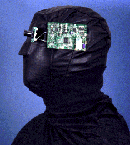
Engaged by Others, Remotely
"(Eduardo Kac) first conceived the Telepresence Garment in 1995 to investigate the notion of the mediascape as an expanded cloth; i.e., to consider wireless networking as a new fabric that envelops the body. The Garment, which I finished in 1996, gives continuation to my development of telepresence art. This time, however, instead of a robot hosting a human, we find the roboticized human body itself converted into a host. The Garment was designed as an interactive piece to be worn by any local participant willing to allow his or her body to be engaged by others remotely." Continue reading >>
Posted by jo at 12:10 PM | Comments (0)
Headmap
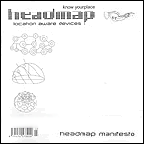
Inside Out
"The Headmap Manifesto [PDF] is a sequence of text fragments dealing with the social and cultural implications of location aware devices. Headmap argues a move from the 'inside' view that developed after the failure of the space programme, the closure of frontiers, the rise of television, early computing, interiorised simulation and drug culture...towards an 'outside' view--a recolonisation of the real world, computers becomming invisible, mobile, networked and location aware, the real world augmented rather than simulated..."
Headmap is an informal guerilla (distributed) think tank. Headmap examines the social implications and applications of location aware devices, augmented social networks, wearable computers, thinking tools and semantic network interfaces.
Posted by jo at 11:27 AM | Comments (0)
January 20, 2005
Tele-tap

Transparent Borders
"Where are the borders between public and private? Between art and life? Between urbanity and individual? - The project Tele-tap by the Amsterdam women artist group CUT-n-PASTE connected its listeners with a number of personalities active in Amsterdam's nightlife: a member of the Salvation Army, a harbour worker, a musician, a woman strolling through the pubs. Each of these personalities went into his urban environment, in his auditory-communicative hunting ground, lived there his life, played his role, provoked encounters. This was transmitted live by the permanent open mike of their mobile phones. Each of them could be wiretapped by the audience via radio, Internet or at the performance venue. Tele-tap showed how undefinable the borders can become between intimate and public space in a mobile communicating society. The technical »heart« of the project is the Internet, where the mobile phone sound inputs were converted into live audio streams and were audible all over the world. These streams also went on air as radio signals, and were accessible by headphones and loudspeakers at the performance venue itsself. The last time Tele-tap was live aired and live performed was on August 31 and September 1, 2001 on the Dutch radio channel VPRO and at »De Balie«, an Amsterdam cultural center. New technologically and dramaturgically extended versions of the project are in preparation. [via AudioHyperspace]
Posted by jo at 03:19 PM | Comments (0)
E L E C T R O N I C S P A C E
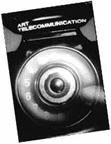
Telecommunications Projects: Robert Adrian
"...products or objects resulting from a telecommunications project are mere documentary relics of an activity that took place in the electronic space of a network. But this kind of problem had already been confronted during the 70's by performance artists who found that their work had been reduced to scrapbook photos, card files and dinner party anecdotes.
The electronic space in which telecommunications artists - along with transnational corporations, stock markets and the military - operate is a complicated concept made possible by another phenomenon of art in the 1970's ... conceptual art. Conceptual art demands a conceptual space in which to exist and a culture that has grasped that elusive notion will have no trouble at all de-materialising its power structures into something as relatively concrete as the electronic space of international electronic communications networks.
But, although Performance Art had shown how artworks could be related to duration (time-based) and Conceptual Art had shown how they could be located in conceptual space (dematerialised), it was Mail-Art with its concept of postal space - a blizzard of images circling the globe through the integrated postal services - that made it possible to conceive of artworks in the electronic space of the new networks." Robert Adrian
Nettime Interview with Tilman Baumgaertel
AudioHyperspace Interview with Sabine Breitsameter
Posted by jo at 02:50 PM | Comments (0)
Magic Location and Locative Media

Horst Konietzny in Conversation with Sabine Breitsameter
"For many years dramaturgue and director Horst Konietzny/Munich has been exploring digital media's performative potential. In 2003 and 2004 his project REACT - Literature in Everday's Life has been investigating the behaviour of passers-by in the urban environment, "captured" by watching authors whose writings are projected - immediately during the writing process - on nearby public screens. Without wireless transmission technologies this project would be impossible. Within the symposia The Art of Mobile Experience (Augsburg 2003 and Munich 2004 ff.) Konietzny created - together with K.P. Ludwig John and Jürgen von Stenglin - a forum for discussing mobile technology's aesthetic effects on art and popular culture." Continue reading >>
Posted by jo at 02:36 PM | Comments (0)
the Electronic Guy
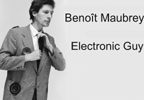
Performing Electro-Acoustic Clothes
Benoit Maubrey performs the Electronic Guy (guitar, sampler, electroacoustic Jacket, solar radio); Video In Studios, Vancouver February 14th, 8:00 PM; and Location 1, NYC, February 18th, 8:00 PM. Following the performance will be a video and slide presentation concerning Die Audio Gruppe.
Benoît Maubrey is the director of Die Audio Gruppe, a Berlin-based art group that builds electro-acoustic clothes and performs in them. Equipped with movement and light sensors, radio receivers, sound generators, samplers, amplifiers, loudspeakers - the clothes produce sounds by interacting with the environment and in response to the performers' movements (past examples: AUDIO BALLERINAS, AUDIO GEISHAS, AUDIO STEELWORKERS, BONG BOYS, AUDIO PEACOCKS...).
Stay tuned for Phonomaniacs (see web site): Maubrey's visit is the opening movement in a larger cooperative project between Die Audio Gruppe and local artists being planned for later this year. It will consist of a series of workshops followed by a sound event featuring 20-30 electro-acoustically costumed performers.
Posted by jo at 09:56 AM | Comments (0)
January 19, 2005
Interactive Panoramic Cinema

Embodied Spectatorship
Paper abstract: For most of the past 100 years, cinema has been the premier medium for defining and expressing relations to the visible world. However, cinematic spectacles delivered in darkened theaters are predicated on a denial of both the body and the physical surroundings of the spectators who are watching it. To overcome these deficiencies, filmmakers have historically turned to narrative, seducing audiences with compelling stories and providing realistic characters with whom to identify. This paper describes several research projects in interactive panoramic cinema that attempt to sidestep the narrative preoccupations of conventional cinema and instead are based on notions of space, movement and embodied spectatorship rather than just storytelling. Example projects include interactive works developed with the use of a unique 360 degree camera and editing system, and also development of panoramic imagery for a large projection environment with 14 screens on 3 adjacent walls in a 5-4-5 configuration with observations and findings from an experiment projecting panoramic video on 12 of the 14, in a 4-4-4 270 degree configuration. [via USC Interactive Media Division]
Title: "Experiments in Interactive Panoramic Cinema"
Location: USC Zemeckis Center, Room 201
Time: 6:00pm-8pm, 1/19/2005
Steve Anderson, Susana Ruiz, and Scott Fisher will give a summary of the work done over the past year with Sony's Fourth View panoramic video camera system. This will be a runthrough of a paper to be given by Steve tomorrow in the annual SPIE conference in San Jose on "The Engineering Reality of Virtual Reality 2005" chaired by Mark Bolas.
Posted by jo at 05:43 PM | Comments (0)
TellBush.org

Giving Bush An Inaugural Ear Full
Announcing TellBush.org, An Experiment In Telephonic Democracy. Call 1.800.734.1463 to leave a voice message for bush. Your voice message will appear on TellBush.org--and a flag gradually builds on the web site--and get itself emailed to Bush at the Whitehouse.
Posted by jo at 05:22 PM | Comments (0)
Transfers
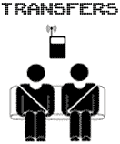
GPS+Video/Audio+You=Mobile Art
Transfers--by Matt Roberts--is a project exploring real-time generation of art and user participation in a mobile environment. Transfers allows a passenger of a taxi to generate a unique piece of art by giving the taxi driver directions. As the taxi moves through the city the passenger experiences a real-time manipulation of live exterior video and audio taken from a camera and microphone mounted in the taxi. The taxi is also equipped with a GPS that feeds an onboard computer data such as speed and direction. This computer is running custom audio/video manipulation software and uses GPS data to make decisions about how the live video/audio feed is manipulated and seen by the passenger. The manipulations of the live feed is displayed on two LCD screens and heard through the cars stereo system. As the user tells the driver where to go the passenger becomes both performer and viewer as they experience a unique piece of art generated by their decisions. The software also records this performance and at the end of the drive the passenger receives a CD with a QuickTime movie file of his or her recorded performance. [via Rhizome] Related >>
Posted by jo at 02:56 PM | Comments (0)
F2T (Free to Talk?)

SMS Rapper Slang
F2T is an interactive musical installation about "argot" and its different contemporary applications. F2T, a creation by artists Frank Plant (United States) and Thomas Charveriat (France), combines sculpture, robotics, hip hop, and SMS messaging to explore the ways technology shapes the development of language, particularly new forms of slang. Viewers interact directly with the artwork by sending it a short text message from their mobile. Once received, the SMS is scanned for frequently used words and, when a match is found, the four elements are activated. The main piece, "Rapper" begins to twist and wave his hand while mouthing a rap based on the message sent, the new lyrics culled from more than 130 different hip hop phrases written by Amsterdam-based lyricist and composer Jim Barnard. The rest of the piece is simultaneously set into motion: "Boom Box" starts flashing and blasting out the song while "Joy Ride" a bouncing low-rider, and "Shake Ass" (looks like it sounds) begins to move, triggered by ambient sound sensors. When the song is finished, a thermal printer spits out a souvenir with the original SMS and the words of the "Rapper." (via Rhizome)
Posted by jo at 02:50 PM | Comments (0)
Trekhprudny Lane

A Waste of Time and Money
Photo (left): MOSCOW 16.1.1992, by Alexander Gormatiuk, Vladimir Dubosarsky, Avdey Ter-Oganian, and Alexander Kharchenko: A tour guide was hired to guide the public with a megaphone on a four hours bus trip around Moscow. The trip included all the typical Moscow sight-seeings as well as some carefully selected liquor stores and it finally ended up where it had started, at the Trekhprudny Lane.
"The history of Trekhprudny Lane began in 1990, right after the end of the "USSR boom" in Western art institutions and shortly before the collapse of the USSR. Avdey Ter-Oganian arrived in Moscow from a provincial Town called Rostov-on-Don, together with some artist-friends in order to conquer Moscow with their artist-group called "Art or Death". The artists squatted a building on Trekhprudny Lane, a street in the center of Moscow, where they installed individual studios and a gallery space in common. They defined their gallery program as a "waste of time and money" and enjoyed their burlesque weekly openings together with the Moscow art community that soon found its way to Trekhprudny Lane." Kristofer Paetau [via Rhizome]
Posted by jo at 02:31 PM | Comments (0)
Fictional Space
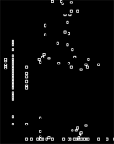
Mapping and the need for Creative Intervention
"Lately I've (Pall Thayer) been toying around with the idea of using *precision, digital locative* media to create fictional space. I've found that bluetooth mapping is better for this than GPS because bluetooth is just one dimensional so to map out a two dimensional space there has to be some *creative intervention*, if you will. This mapping was done by logging bluetooth proximity readings for approximately one hour. The first half hour is used for the x axis and the second half hour is used for the y axis. It's running at 4 times the real speed so you don't have to actually stare at it for half an hour to see the whole thing."
Posted by jo at 12:19 PM | Comments (0)
Location is Everything

Rhizome.org ArtBase Exhibition
Location is Everything--curated by Jillian Mcdonald--explores ways in which artists repurpose mapping as a creative medium; or perhaps it reframes mapping as a procedure that is intrinsically creative. The cartographic forms in these projects are drawn according to, as Mcdonald explains, personal or collective experiences, some informed by external factors like weather data or pop-culture references, and some allowing the map itself or local residents to inform them. These reciprocal actions of forming and informing effect both maps and their makers, suggesting that who? and why? are equally important questions to pose when interpreting a map as simply where?.
Works included in this exhibition are "PdPa" (2003) by Julian Bleecker, Scott Paterson and Marina Zurkow, "[murmur]" (2003) by Shawn Micallef, "Louisiana Walk #14" (1996) by Janet Cardiff, "Atmospherics/Weather Works" (2003) by Andrea Polli, "GPS Drawing" (2000) by Jeremy Wood, "Hlemmur in C" (2004) by Pall Thayer, "Survey Field" (2003) by Germaine Koh, and "Infrasonic Soundscape" (2001) by Hidekazu Minami.
Posted by jo at 12:03 PM | Comments (0)
Aware Platform

collective publication and syndication of mobile media
The Aware platform is a design tool and a production environment. It allows for collective publication and syndication of mobile media.
Working from the lowest common technological denominator to maintain flexibility and inclusiveness, a person can use whatever media capture-device they have available. More important is, what contextual information is associated - such as proximity, location, temporality, theme and event.
Aware focuses upon bundling these relationships, both automatic and given, to the media. Contributions are made via a networked-device, using common protocols such as email, SMS, MMS, or a custom application.
The Aware platform consists of three enveloping layers: interface, process, storage. The outermost interface layer is extendable, modular and reacts to project requirements - it is the layer people interact with when contributing and experiencing media. A process layer bonds the interface and storage layer together, translating data in both directions into formats that each element of the system can process. Meanwhile, the innermost storage layer is in essence a data structure that enables the association of media with context information.
There are two representable formats of this process - the packet itself (encapsulating the media and context information) or a feed of a series of packets, ordered according to certain filters. These formats may be distributed in human or computer-readable representations with graphical-user-interfaces, XML or RSS.
In this way, a person at the receiving end of these representations experiences contributions through casual browsing, subscribing to a feed, or with message notification, via interaction with a networked-device. The act of browsing itself generates filtered views, which can be saved as feeds, making them accessible for that person or for others. This feedback flow indicates the potential collective process in the sharing of mediated context and experience between people.
See projects developed with the Aware platform. Their project Rengo (based on a poetry practice originating from medieval Japan, based upon collective activity and linked-verse) explores mobile media participation logics, collaborative tools, self-documentation, design practice, mobile media projects and systems. Rengo was presented at ISEA 2004.
Posted by michelle at 11:30 AM | Comments (0)
Tactical Media

Definitions
Critical Art Ensemble's definition of Tactical Media:
"Tactical Media is situational, ephemeral, and self-terminating. It encourages the use of any media that will engage a particular socio-political context in order to create molecular interventions and semiotic shocks that contribute to the negation of the rising intensity of authoritarian culture."
Posted by jo at 11:19 AM | Comments (0)
January 18, 2005
Guest Blogger
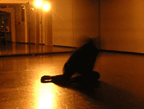
Welcome Yukihiko YOSHIDA
Yukihiko YOSHIDA is dance researcher, critic, and PhD. Candidate at the Graduate School for Media and Governance at Keio University, Japan. He works for WDA Asia Pacific: Research Documentation Network; is principal investigator and project leader for Association for Dance and Performance Telematics [ADaPT], Tokyo; and is assistant to Ted Nelson and Project Xanadu, "The Original Hypertext Project." View his website and CV.
Posted by jo at 12:32 PM | Comments (0)
Sound Mapping

Sound Sense of Place
Sound Mapping is a participatory work of sound art made for outdoor environments. The work is installed in the environment by means of a Global Positioning System (GPS), which tracks movement of individuals through the space. Participants wheel four movement-sensitive, sound producing suitcases to realise a composition that spans space as well as time. The suitcases play music in response to nearby architectural features and the movements of individuals. Sound Mapping aims to assert a sense of place, physicality and engagement to reaffirm the relationship between art and the everyday. Paper; Images; Video; mp3.
Posted by jo at 06:51 AM | Comments (0)
Tap
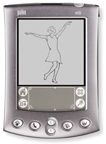
A Metaphor for Networked Communication
Tap--by James Buckhouse in collaboration with Holly Brubach--is a virtual dance school for animated characters that exist on the Internet and can be downloaded to individual users’ Personal Digital Assistants (PDAs) and desktops. Users can choose animated dancers (a male or female) at the Tap website. The dancer takes on a life of its own, practicing, learning from other dancers, and giving recitals. Users do not have to be present during the lessons--the animated characters can be "dropped off" and left to practice for an unlimited time. Dancers can practice at home, as a screen saver on the user's desktop. Their learned routines can be performed for other users.
These performances take place on individual users' PDAs. Dances are downloaded from users' desktops or beaming stations to their PDAs, where they can be performed as well as "beamed" to other PDA users. The dance contains a record of what it took to learn a particular routine. Individual steps from a dance can be incorporated into new dances, and users can encourage their character to continue working with certain moves. Also, two users can let their characters teach each other to dance.
Tap treats digital data not as perfectly reproducible packets of information, but as seeds for new ideas that spread and evolve. As an artwork that relies on exchange, learning processes, and community, Tap becomes a metaphor of networked communication itself. As digital data, tap dance is modular and re-mixable. The similarities between data and the dance routines point to the question of how we think about art through the cultural filter of technology.
Posted by jo at 06:15 AM | Comments (0)
January 17, 2005
Mutsugoto/Pillow Talk
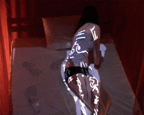
A Body-Drawing Communicator for Distant Partners
Mutsugoto--by Tomoko Hayashi, Stefan Agamanolis, and Ciaran McGrath--is an intimate communication device placed in the bedroom environment. Instead of exchanging e-mail or SMS messages using generic interfaces in business-like venues, Mutsugoto allows distant partners to communicate through the language of touch as expressed on the canvas of the human body. A specialized computer vision and projection system allows users to write or draw on their own bodies while laying in bed. Drawings made by one partner are transmitted to and revealed on the body of the remote partner. [via medialab europe]
Posted by jo at 10:15 AM | Comments (0)
Grafedia
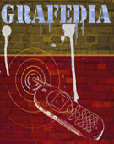
GraffiTML
Keyboards often eclipse pens as the writing tool of necessity. As computers continue to gain precedence in our lives, we fill a graveyard with lost penmanships and John Hancocks of decreasing legibility. John Geraci combines the personal imprint of handwriting with the connective possibilities of the Internet in his newly released project Grafedia, developed at NYU's Interactive Telecommunications Program. Elaborating on themes explored in neighbornode--a wireless, localized bulletin network Geraci built in 2004--Grafedia turns the city of New York into a potential webpage. An author can write, draw, even tattoo, a hyperlink onto a public space in the form: my_original_thought@grafedia.net. The author also uploads media corresponding to or enhancing to the location, like an original photograph, to the Grafedia site. Passers who encounter a link can 'click' it by sending a text message to my_original_thought@grafedia.net. In turn, Grafedia beams the author's hidden media back to the inquiring wireless device. Since Grafedia's annotative marks are not anonymous but in fact scrawled by the hands of their authors, viewers are able to follow particular people and stories. And the cherry on top my original photograph? It's a lot fun. - Alyssa Wright, Rhizome's Net Art News.
Posted by jo at 09:38 AM | Comments (0)
January 16, 2005
Suspending Disbelief
![im6[1].jpg](http://www.turbulence.org/blog/images/im6[1].jpg)
Stretching Conversations
Suspending Disbelief, by Anne Niemetz , is a performance in which four persons create music by stretching their suspenders. The suspenders have built-in bend sensors that trigger Larry King statements taken from his tv-show (King was known for his habit of "suspender-stretching.") The performers have the possibility to select, scratch and replay king's voice, in much the same way a dj can while playing records. The choice of sampled words and sentences lets the performers converse with each other about suspenders, showbusiness and the current social and political situation. (Posted by Régine Debatty)
Posted by Regine at 03:15 AM | Comments (0)
January 15, 2005
PLAN - The Pervasive and Locative Arts Network
![]()
Two Day Workshop
The Pervasive and Locative Arts Network (PLAN) is a new international and interdisciplinary research network in pervasive media and locative media funded as part of the UK Engineering and Physical Sciences Research Council (EPSRC) Culture & Creativity programme. The network will bring together practising artists, technology developers and ethnographers with the aim of advancing interdisciplinary understanding and building consortia for future collaborative projects. It will be of relevance to people working in the arts, games, education, tourism, heritage, science and engineering.
You are invited to attend an initial two day workshop that will launch the network, review the state of the art, bring key players together, and make initial contacts. The event will also aim to identify a range of specific interests that can lead to the formation of sub-groups within the network.
Speakers include: Duncan Campbell, Anne Galloway, Matthew Chalmers, Matt Adams, Bill Gaver, Eyal Weizman, Katherine Moriwaki, Sally Jane Norman, Giles Lane, Usman Haque, Franz Wunschel and the Exyzt collective, Richard Hull, Jo Walsh, Schuyler Erle, Teri Rueb, Minna Tarkka, Tapio Makela, RIXC, Pete Gomes, Saul Albert, Susan Kennard, Michael Longford, Steve Benford, Drew Hemment, Ben Russell. [Full list of speakers below]
ICA (Institute of Contemporary Arts) London UK; Tues 1st and Wed 2nd February 2005, 10am-6pm (music 8pm-1am Tuesday).
Music in the bar from Xela (City Centre Offices, Type Records), XFM Flo-Motion DJ Nick Luscombe and Apachi61.
PLAN is supported by EPSRC and led by Nottingham's Mixed Reality Lab, with partners including Futuresonic (UK), Banff (Canada) and M-cult (Finland).
The event is open to the public. Event tickets are priced at £1.50 per day or £3 for two days to cover the ICA daily membership. Please book early to avoid disappointment. [See below for registration process.]
EVENT PROGRAMME - SPEAKERS
DAY ONE: February 1st 2005; ICA London; 9:30am registration 10am start
Matthew Chalmers - Glasgow University
http://www.dcs.gla.ac.uk/~matthew/
Bill Gaver - RCA
http://www.rca.ac.uk/pages/research/dr_william_gaver_609.html
Eyal Weizman - Architect
www.cabinetmagazine.org/events/weizman.php
Sally Jane Norman - Culture Lab, University of Newcastle
http://kvc.minbuza.nl/uk/archive/commentary/norman.html
Cliff Randell - Computer Science Department, University of Bristol
http://www.cs.bris.ac.uk/~cliff
Wilfried Hou Je Bek - Socialfiction
http://socialfiction.org
Giles Lane - Proboscis
http://proboscis.org.uk
Matt Adams - Blast Theory
http://www.blasttheory.co.uk/
Usman Haque - Bartlett School of architecture
http://www.haque.co.uk
Franz Wunschel - Exyzt Collective
http://www.exyzt.org
Richard Hull - Hewlett-Packard Laboratories
http://www.mobilebristol.com
Constance Fleuriot - Bristol University
http://mobilebristol.com
Jon Dovey - Bristol University
http://www.republicof.net
Debbi Lander - Futurephysical
http://futurephysical.org
Giulio Jacucci - Helsinki Institute for Information Technology (HIIT)
Advanced Research Unit (ARU)
http://www.hiit.fi
Annika Waern - Swedish Institute of Computer Science
http://www.sics.se/~annika/
RIXC
http://rixc.lv/
Pete Gomes - Architectural Association
http://www.mutantfilm.com
Saul Albert - Twenteenthcentury, Limehouse Townhall
http://twenteenthcentury.com/cv.php?mem_id=1
Susan Kennard - Banff
http://www.banffcentre.ca/bnmi/
Michael Longford - Mobile Digital Commons Network
Tobias C. Van Veen - Mobile Digital Commons Network
Naomi Spellman - UC San Diego
http://34n118w.net/
Brett Stalbaum - UC San Diego
http://visarts.ucsd.edu/faculty/bstalbau.htm
Minna Tarkka - M-cult
http://www.m-cult.org/
Tapio Makela - M-cult
http://www.m-cult.org/
MUSIC PROGRAMME: February 1st 2005; ICA London; 8pm-1am
Xela (City Centre Offices, Type Records)
XFM Flo-Motion DJ Nick Luscombe
Apachi61
In association with Baked Goods and Futuresonic
http://www.baked-goods.com
http://www.futuresonic.com
DAY TWO: February 2nd 2005; ICA London; 9:30am registration 10am start
Duncan Campbell - IPTV, The Guardian
http://duncan.gn.apc.org
Anne Galloway - Carleton University
http://www.purselipsquarejaw.org
Katherine Moriwaki - Trinity College Dublin
http://www.kakirine.com
Jo Walsh - Co-author 'Mapping Hacks'
http://space.frot.org/
Schuyler Erle - Nocat, Co-author 'Mapping Hacks'
http://nocat.net/
Teri Rueb - RISD
http://www.terirueb.net
Erich Charles Harris - Interact Lab, Informatics, University of Sussex
http://www.cogs.susx.ac.uk/interact/
Lalya Gaye - Future Applications Lab, Viktoria Institute
http://www.viktoria.se/lalya
Martin Rieser - Bath, BFI
http://mobileaudience.blogspot.com
Ewen Chardonnet - Ellipse
http://e-ngo.org
Sarah Kettley - Napier University
http://www.eca.ac.uk/tacitus/SarahKettley.htm
Andrew Wilson - Blink Media
http://fisharepeopletoo.blogs.com/1/2004/09/city_chromosome.html
Karl-Petter Akesson - SICS
http://www.sics.se
Jen Southern - University of Huddersfield
http://www.theportable.tv
Russell Beale - Advanced Interaction Group, School of Computer Science
University of Birmingham
http://www.cs.bham.ac.uk/~rxb/
Steve Benford - MRL Mixed Reality Lab
http://www.mrl.nott.ac.uk
Drew Hemment - Futuresonic, University of Salford
http://www.futuresonic.com/
Ben Russell - Headmap / Locative
http://headmap.org
Full details of the PLAN ICA workshop, and updates to the programme can be found on the PLAN website.
REGISTRATION
Registration is a two-step process:
1]. Book tickets via ICA
Tickets, priced at 1.50 (GBP) per day, are available from:
the ICA Box Office: 12 Midday - 9:30 pm
Email: tickets@ica.org.uk
Tel: +44 (0)207 930 3647
ICA Address - ICA. The Mall. London SW1Y 5AH
ICA Website - http://www.ica.org.uk
2]. Provide contact details to lra@cs.nott.ac.uk as below
If you would like to be included in the PLAN networking activities
and delegate list, please send the following contact details to
Linda Andrews, lra@cs.nott.ac.uk
Name:
Organisation:
URL:
Address:
Email Address:
Tel No:
Areas of Interest:
Posted by jo at 09:51 AM | Comments (0)
January 14, 2005
Permanent Creation
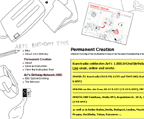
Art's Birthday 2005
This year's Art's Birthday celebrations in Vienna stand under the motto Permanent Creation and will - as in previous years - take place as a networked project with partner nodes around the world joining in and contributing to the broadcast special. For the first time, also the Ars Acustica group of the European Broadcasting Union (EBU) will participate in the Art's Birthday special and send acoustic contributions and sound samples serving also as source material for new pieces via satellite, thus expanding the global network by national broadcasting companies in Baden - Baden, Berlin, Madrid, Moscow, Oslo, Prag, Stockholm and Vienna.
In Vienna, the artist groups alien productions and IFTAF - Institute for Transacoustic Research will perform and jam with the partners of the network and will stage miniature performances due to instructions either submitted by the audience or from a collection of action instructions. For these performances, there will be a range of props available in the studio and each of the short acoustic actions will be performed within a fixed setting: a white table equipped with various (analogue) tools.
You can add your instruction for Permanent Creation to an on-line pool, which is the base material for the miniature performances. Furthermore, listeners of Kunstradio as well as artist collegues are invited to come to the studio and join in the action.
on air: OE1 Kunstradio (FM, SW, MW) - 21:00 - 23:00 GMT
on line: http://kunstradio.at
on site: Funkhaus, Studio 3, Argentinierstr. 30a, A - 1040 Vienna
The History of Art's Birthday
WIENCOUVER 2000
"In 1980, when the modern Fax machine was still an exotic promise and computers either massive mainframes or playthings for the hobbyist, artists in Vancouver and Vienna were collaborating on the first of the projects known as Wiencouver. WIENCOUVER 2000 is not a nostalgic look at the early years of Art+Telcomm but an exploration of the new technology available for artists working in the field as we approach the new millenium."
"Art's Birthday Party is a celebration in memory of Robert Filliou who declared, on January 17, 1963 that Art had been born exactly 1,000,000 years ago when someone dropped a dry sponge into a pail of water. 10 years later he celebrated Art's 1,000,010th birthday in the Neue Galerie, Aachen.
After Filliou's death in 1987 some artists began to celebrate Art's Birthday with mail-art, fax and slow scan tv events in the spirit of his concept of "The Eternal Network" or "La Fete permanente." The Birthday parties took place in different cities across the world and artists were asked to bring birthday presents for Art. -- works that could be shared over the network.
Art's Birthday Party has never been a formal event but was always organised on an ad hoc basis through the network. Every participating location (and they are different every year) organises its own party - from a few friends in a private studio to a performance evening in a museum, gallery or radio station . The only condition is that each group is able to send and receive birthday presents for Art. Since 1994 this has usually meant using the Internet in one form or other.
Filliou's invention of Art's Birthday is wonderfully absurd and humorous in the typical Fluxus tradition of serious fun. So the global birthday party for art has always tried to be fun while paying homage to Robert Filliou's dream of The Eternal Network." Robert Adrian 2004
Art's Birthday Network
EBU Ars Acustica Special Evening
Posted by jo at 12:26 PM | Comments (0)
Kododama

Solid conversations
To represent the sensation that spoken words are somewhat tactile and occupy a certain space, Japanese artist Hisako Kroiden Yamakawa created Kododama, an installation of interactive voice containers. Objects made of polyester and rubber float in the exhibition space, their shape inspired by the voice bubbles of comics.
When a visitor picks up a stethoscope and touches the voice bubble object, s/he can listen to messages which have previously been stored inside the bubble by others. To record a message into the bubble the user touches the nozzle of the voice bubble and speaks into the microphone integrated, while a small light indicates the recording process. The recording also triggers the voice bubble to inflate through integrated compressors and pump. But the bubble gradually deflates when users listen to the messages through the stethoscope.
Related: planting sounds in the city, communication via urban audio tags. Blogged by Regine on near near future.
Posted by jo at 10:02 AM | Comments (0)
800-178968

...I'll Call You
800-178968--by Luca Bertini--was a toll-free number that attempted to establish an obsessive and addictive relationship with individuals. It called people back, even after a few weeks, and pleaded with them to come back.
800-178968 was invasive, insinuating itself into the homes and mobile phones of people, violating their privacy, and becoming part of their daily lives. The advertisements for it--which began three months before the start of the service--were hidden among information channels (by adopting their language, codes and instruments), thus were able to reach an unaware, vulnerable audience. The project ended on July 2003 with over 10.000 people contacted. [via Rhizome]
Posted by jo at 09:30 AM | Comments (0)
January 13, 2005
database

Present Time Always Passing By
database is an electronic reading device that deals with the inversed functionality of three electronic devices: a printer, a video camera and a database. Consequently, it raises issues about the erasure of text, the act of reading in real time (i.e., listening to a printed text), and physical databases. Through the opposition between presence vs. absence, recording vs. erasure, memory vs. forgetfulness, present vs. continuous time and reading vs. listening, we challenge the idea of the database as a non-linear and digital structure, and the printer as an output device as well as an information recorder. Critical for the connection of all these concepts is the idea of present time as a time that is always passing by.
Posted by jo at 08:33 AM | Comments (0)
OptionalTime/Public Expanse

Between Reality and Fiction; Before Meets After
OPTIONALTIME/Public Expanse, by Joes Koppers and Susann Lekås, uses new new media to make a non-linear experience tangible in public space...It appears as a big mirror that in fact is an interactive movie...OPTIONALTIME/Public Expanse is a layered projection visually blended into one 'real' image. One layer is pure fiction and has been filmed by the artists, forming their most direct (personal) contribution...(It) uses cameras with full transparency; what is recorded is shown and nothing is archived. All images are processed in real-time by a computer, resulting in playback that sometimes is 'live' (a normal mirror image), sometimes buffered (delayed or accelerated image) and sometimes spatially manipulated. The playback 'mode' of the projection is directly controlled by the actions of the public.
Posted by jo at 08:24 AM | Comments (0)
Mogi
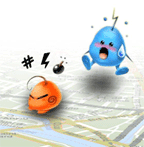
Location-Based Gaming
"Real and virtual have finally met in fun - reporting on Mogi, the brilliant location-based online multiplayer experience in Tokyo. Now phone networks are faster and more mobile devices know where they are, permitting a second generation of location-based multiplayer games. Undoubtedly the leading second-generation mobile phone game is Mogi: Mogi uses both the position of players in the landscape, and the landscape itself to generate play...Mogi is a collecting game - "item hunt". The game provides a data-layer over the city of Tokyo. As you move through the city, if you check a map on your mobile phone screen, you'll see nearby items you can pick up and nearby players you can meet or trade with." From Mogi: Second Generation Location-Based Gaming by Justin Hall, theFeature, April 1, 2004.
Posted by jo at 08:11 AM | Comments (0)
Surface Patterns: Walking Tours
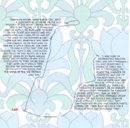
10 People. 10 Walks. 10 Stories Told.
Walking Tours and Audio Tours are two new works by artist Jen Southern commissioned by centrifugalforces and the media centre for Surface Patterns. Both works use a Global Positioning System (GPS) device to explore how memory is linked to urban and domestic places. The GPS device can only describe latitude, longitude and altitude: however, when used to trace the route that someone walks through a place, it can reveal the pattern of the path taken, allowing us to share knowledge of hidden locations and unexpected vantage points along the path.
Traditional maps tell us where landmarks are, what streets are called and where to find the centre of town, whereas the subjective histories and stories explored in this work are played out over time and rely on very different 'memory maps'.
The installation Audio Tours at the media centre uses contributions of unwanted wallpaper, pasted on the gallery wall and threaded or punctuated with GPS patterns of 10 walks. Traces of audio recordings made in conversation with the walkers are manipulated and played back in the gallery, recalling the simple flipping, mirroring and inverting techniques employed in the patterns of the wallpaper. Reflecting different perspectives on the town, the walkers include members of the artists family who grew up in Huddersfield in the 1940s and 50s, as well as a previous Artist in Residence at the Digital Research Unit in The Media Centre who lived in the town for three months. Memories range from the last Sex Pistols gig to architectural history (both public and domestic) and personal freedoms of walking in urban space.
Walking Tours consists of 10 PDFs to download and print, each using a wallpaper pattern, a walked route, and a story about Huddersfield.
Jen Southern is an artist who lives and works in Huddersfield. Her process-based practice investigates everyday journeys between virtual and physical spaces, using socially embedded technologies such as video games and mobile phones. She has been working with global positioning devices for the past two years; recent projects using GPS: Area Code (www.areacode.org.uk) with exhibitions at Magna, The Museum of Science and Industry and Artranspennine 03. Jen's work has been exhibited nationally and internationally in public spaces galleries and festivals.
Posted by jo at 07:53 AM | Comments (0)
Gravity and Resistance

Gravity as an interface of perception
Artist Mikami Seiko and architect Ichikawa Sota see gravity as an interface of perception, claiming "the interface itself exists inside us."
Their installation Gravity and Resistance presents the dynamic processes of the interactions between gravity and resistance: a dialogue between the body and space.
Each participant becomes "an observation point," and another participant joins to make "plural moving observation points." The number of participants at a time is not limited.
Sensors detect instantly and continuously the changing position, weight, and speed. Based on the relations among participants' dynamics, GPS in the sky above the site, and changes in the space, another space is created by light, sound, and images.
Implicit in the resistance of gravity is the social dynamic/collaboration among the participants as active agents creating the gravitational traces. See more detail on their site.
Posted by michelle at 03:45 AM | Comments (0)
Displaced_Persons
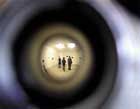
Absolute immobility installation
Displaced_Persons, by Christin Lahr, explores the interfaces between physical and virtual spaces, as well as interhuman communication.
In a room, one finds 8 loudspeakers and 8 red signs with the words engraved: north, south, east, west, up, down, in, out. A multi-voiced polylog of synthetic characters can be heard, discussing absence, truth and lies, sex, appearance, identity, and detection.
When people enter, the polylog abruptly breaks off until they either leave the space or remain completely motionless. Only the total immobility of everyone triggers the sound installation. In this way, a situation of interdependence(net_working) develops. Every individual influences the entire happening, and the result is a joint expression of everyone involved.
Visitors become fixed in the space as living sculptures and thus, at the same time, exhibits themselves.
Through 4 spyholes, events in the space inside can be monitored. The observer notices that the distance is only a relative one if he becomes, by observing, the one observed. All of this can also be tracked on the web via surveillance cameras. The cameras of all logged-in users are also collectively controlled so that every individual can influence all in-coming video. This is projected parallel to the exhibition via beamer. The arising 'cuts' result directly from the user's clicking behaviour and also document their activity. Likewise, texts can be fed into the website and immediately be heard through a loudspeaker found in the room, thus furthering the "polylof of fictitious identities". (Posted by Régine Debatty)
Posted by Regine at 12:22 AM | Comments (0)
January 12, 2005
HopStory
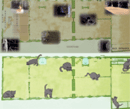
Interactive, Location-based Narrative Distributed in Space and Time
"As computing and communications technologies evolve, there is the potential for new forms of digitally orchestrated interactive narratives to emerge. In this process, balanced attention has to be paid to audience experience, creative constraints, and presence and role of the enabling technology. This paper describes the implementation of HopStory, an interactive, location-based narrative distributed in space and time, which was designed with this balance in mind. In HopStory, cinematic media is housed within wireless sculptures distributed throughout a building. The audience, through physical contact with a sculpture, collects scenes for later viewing. Inspired by the history of the installation space the narrative relates a day in the life of four characters. By binding the story to local time and space and inviting the audience to wander, we amplify the meaning and impact of the HopStory content and introduce an innovative approach to a day-in-the-life story structure." Abstract for Hopstory: an Interactive, Location-based Narrative Distributed in Space and Time by Valentina Nisi, Alison Wood, Glorianna Davenport and Ian Oakley [PDF]
Posted by jo at 02:57 PM | Comments (0)
EyeToy
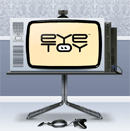
Embodied interaction (and seduction) in games Technologies of Cooperation
Andrew Losowsky looked in an article in Guardian at the technology behind the success of Sony PlayStation2's EyeToy. Recently he followed this up in his weblog quoting Gonzalo Frasca, a researcher in computer games at the IT University of Copenhagen who emphasizes the impact of embodied interaction in games.
"With these games, players can use their bodies to communicate, to express themselves," says Gonzalo Frasca, "In addition to your play style, you also have your body language style. For example, some EyeToy players will try to make minimal movements, while others enjoy doing more grotesque ones. Lots of people also enjoy doing movements that are not functional to the game itself, like spinning or jumping, just because it's a cool thing to do and they are aware that they have an audience."
Posted by Gerrit Visser on Smartmobs, originally from OLDaily
"There are two main reasons why it works so well," says Gonzalo Frasca, "The first and obvious reason is that it is extremely easy to learn and it involves a very natural interface: body movements. But the most important reason for its popularity is that it is also a fun game to watch. People make a lot of goofy movements while playing it, so it is very enjoyable for non-participants.
The transformed game structure has some interesting aspects that the original game does not have. In the transformed game, the players have included an element of conscious choice in the rules by including an action where they have to choose whether it is profitable to do calculations to make a piece. Making the right choice depends on cooperation and interaction between group members in the physical space...
The design of both hardware and software for a camera-based interface is a new challenge. Suddenly there is an importance not just on who is playing but exactly where they are doing it, and what the conditions are like in players' front rooms.
Posted by jo at 11:32 AM | Comments (0)
ARQuake

Re-Locating Monsters
ARQuake is an Augmented Reality (AR) version of the popular Quake game. Augmented reality is the overlaying of computer generated information onto the real world. We use a head mounted display, mobile computer, head tracker, and GPS system to provide inputs to control the game. Using ARQuake, you can walk around in the real world and play Quake against virtual monsters...Our task at the moment is to take all the monsters and the guns etc. out of the quake game and to make them roam around a real environment. We also required the player of the game to move around the real world and have all the monsters appear as though they were standing next to and behind real buildings. Read ARQuake: An Outdoor/Indoor Augmented Reality First Person Application [PDF]; view videos.
Posted by jo at 11:07 AM | Comments (0)
Ground Station
![]()
military data makes music
Daniel Jolliffe and Jocelyn Robert's installation Ground Station sets out to make visible different cultural approaches to technology, and to make audible the invisible data that connects these approaches. In this sense Ground Station's performance is not one of music but an aural translation of the current technologized society that we inhabit.
Ground Station produces music in real time by following the current azimuth, elevation and signal strength of twenty-seven Global Positioning System (GPS) satellites. Ground Station (GS) is in a sense an audible reflection of the activities of the GPS network it watches. Whereas GPS was developed as a positioning technology to aid in warfare, GS inverts the traditional use of this data by watching the positions and movement of the satellites themselves. As GPS data is fed into GS, it is processed by an algorithm designed by the artists that filters and transcodes this into musical notation. This unique, continuous musical score is then played live on a Dysklavier piano.
Ground Station works by, in effect, 'borrowing' data from the US military's Global positioning satellite network. There are two sets of authors for the music GS produces: the artist-programmers who create and contextualize the work, and the military infrastructure that maintains and oversees the GPS network. This connection between these authors is a definite one: GS is compositionally dependent on the data it receives from the GPS network, and in turn on the ground system that controls the satellites. The role of Schriever Air Force Base in controlling the music produced by GS is indirect yet significant, as the music produced by GS depends on satellite trajectory, which is under direct military control. Without this ground control, the music produced by GS would eventually fade and cease, in parallel with the decay of the satellites themselves.
Systems aside, GS was not conceived to champion technology or the possibilities of computer-based musical composition. As collaborators we have little interest in the aesthetics of the 'music' produced by the piano. Rather, its goal is to produce music as a kind of cultural artifact of the time and place we live in. Musically, GS relies on the supposition that musical composition is a product of the time and place in which it is produced, rather than its formal or syntactical qualities. A piano played under the rocket fire of wartime Beirut, for example, and GS's piano-manifested satellite data are both musical compositions that reflect specifically upon the social state of the cultures they are created within.
Posted by michelle at 02:40 AM | Comments (0)
January 11, 2005
Code Zebra
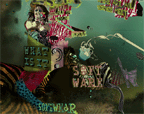
New Artistic Practices Meets Performance Art, Art and Science
Code Zebra is a highly interactive interdisciplinary, performance and software system where art meets science. The performances occur at sites around the world and on the web. CZ induces dialogues and debates between science (with an interest in computer and biological science) and arts (including visual art, design, fashion, architecture). Code Zebra consists of fictional flirtation sessions between an artist and a scientist, actual conversations and debates between the arts and sciences. Code Zebra is built as a scaleable performance series that allow venues to plug and play.
Elements of the development of Code Zebra will be captured in video and Internet streams and form part of a significant archive that will be used in performing the work. Users on the site will experience live events via streamed audio, and at times video. Live events will be publicized through the web site. The project draws from performance theory (art, literature, sociology), discourse theory and grammatology, cross-disciplinary research methods, visualization theory and computer science practice, simulation, new media analysis.
The metaphor of "zebra" is at the core of the project because zebra's stripes are reaction/diffusion patterns; a provocative but resolution based way of describing dialogue. Evolutionary theory uses zebras as a case study, and reaction/diffusion has been at the core of this emerging performance series and at the heart of the operations of computer code. Zebras are the unexpected evolutionary protocol. They stand out in a crowd, but induce nausea in lions, their former predators. Above all zebras survive by moving in camouflaged herds.
Performances will take place in various real and simulated locations. The software of Code Zebra also combines panel discussions and debates, live and on-line, chat, simulated conversations and patterns and visualizations of chat or performance art metaphors using software and fictional performances.
CodeZebra OS (Orifice System) Software
In November and December of 2000, a group of leading artist/software developers, streamed media artists, discourse theorists, chat analysts, computer scientists and programmers gathered in San Francisco, led by Sara Diamond and hosted by the ArtsAlliance. Together, they modeled Code Zebra, a software that will analyze and allow people to author on-line chat, video streams, producing visual patterns that allow users to better understand and symbolize their own position within discussions. The software deploys reaction/diffusion patterns from nature, but permits individuals or groups to have a personalized pattern at any point in time. The design retreat includes some of theworld`s leading thinkers in Internet dialogue analysis, streamed media, and pattern creation. It links to the larger Code Zebra project. The software is capable of analyzing all forms of chat, but will be focused on debates and discussions in art and science as a development phase.
The software provides users with the ability to use visualization patterns to locate themselves within an Internet discussion, review their histories of dialogue, enter a deeply moderated or anarchic space that is designated by topic and/or by mode of chat and feel physically located in this space; monitor other chats simultaneously, use physical links to relate ideas; build a personal pattern icon and a personal tale of chats and Internet dialogues that unfolds as a visually beautiful, navigable, shareable 3D and sound movie.
Fear and self-preservation need to be confronted and transcended in the process of enacting cross-disciplinary exchange. This will be so in the performances and is already a part of the software design process. The performances and the software translate constantly, between the semantic meanings of concepts, people's relationships, into visualization new levels of understanding. The software enables agency (you choose topics and people), but its intelligence constantly suggests new possibilities of idea, related concepts and people for you to connect to. While appearing light, beautiful and playful, this project is in fact serious and viral.
The software development workshop may be a good example of the lock-up technique (referred to later), as the artist placed fifteen top-end researchers and coders in a room with her and several other artists. They came up with the chat visualization software that was a complex melding of computational linguistics, social instincts, and simulations of animal and human physical characteristics and evolutionary logic. First and foremost, they combined an emotional system with the anarchic or unconscious dynamics of Internet interaction. Code Zebra is all about process, allowing a series of lenses on the process of dialogue and creativity. While driven by the vision of one artist, it is highly collaborative and hence high risk, requiring the cooperation of different talents and disciplines for its success.
The user enters each chat or dialogue session by dwelling on the surface of the site and then diving into a familiar or seductive pattern. Once inthe pattern one moves through its moving mass and can stay at any point for dialogue. The software monitors styles of discussion through pattern analysis and can impose patterns on certain kinds of dialogues should these go astray or at least suggest these. Patterns can be used to analyses what people are talking to each other, about what, but most profoundly how they are talking. Character scripts based on the reaction diffusion character team (Code Zebra, Os Zealot, etc.) will arrive in at least text, if not visual form, to moderate discussions or suggest changes of mode (e.g. you have a limit of ten words posting for e.g. and it looks like playful leopard spots). This process of swimming through the topography of the site is called orifice systems (OS).
Each user creates their icon on the site, a moniker for HOW they interact. Each chat sessions produces a pattern that they can capture at any point in time. It forms a ring, or layer attached to their icon. Over time, these layers build to create a personal tale. These are three-dimensional forms that the user can enter, fly through, fly around, pull out layersof for reconsideration. Although highly visual (and eventually sonic), drilling down into these results in precise data base information about whoone has spoken to, about what and in what style (aggressive debate, playful banter, formal panel discussion) at what time. The forms operate as 3D movies, luscious and beckoning. The icons sit on the surface of the site, but at any time, users can share these or revisit these alone or accompanied.
Posted by jo at 06:55 PM | Comments (0)
January 10, 2005
real-time film
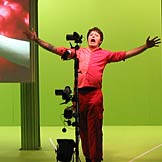
resynthesis of (per)form(ance)
Caden Manson's Big Art Group developed "Real-Time Film" as a conceptual model conflating performance, television, and movies. Using live performance and video, it plays cinematic composition and controlled perspective against the 'verity' of TV broadcast and the immediacy of live performance. It is a live movie that examines the use of image in entertainment, how we experience the image versus its manufacture, the split between surface and interior, and the different layers of truth.
In "Real Time Film" the actors work in front of three stationary cameras, and what those cameras see is projected on a three-segment shoulder-high screen running the length of the stage between the audience and the actors; the performers' heads, shoulders, feet and the projections of their actions are all that's visible. Watching the screen, the audience sees a movie. Watching the performers, the audience sees the making of the movie. Bodies morph into one another and limbs attach and reattach to different characters. It enables an Asian woman to play a white woman with a black man’s arm. The form short-circuits the audience’s ability to discern gender, race, and sexuality; dissecting the semantics of everyday visual communication; and becoming a new way of relating the fluidity and manufacture of identity.
The technical analysis and resynthesis of the form carries through to the infrastructure of the text, the reestablishment of character, and the nature in which expectations of drama are met and deflected. Language is made transparent and meaningless and simultaneously overloaded with possible meanings, and traditional methods of establishing and acting character are exploded and then recombined in the attempt to generate new modes of identity and identification. Narrative plays with the idea of development and frustration, intentionally exposing circular patterns and the inconsistency of structure while using conflict/resolution to push forward.
Posted by michelle at 07:10 PM | Comments (0)
Stereotactic
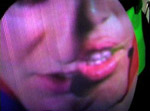
Video mixing as analogy
Stereotactic is a performance project by Michelle Kasprzak and Michelle Teran that was first performed in 2001.
A series of internet searches is conducted, using the five performance parameters as search terms. These searches are the visual research that the performance gestures and set design is based on.
Performance parameters/Search terms:
1. two performers
2. live video mixing
3. the projection
4. the screen
5. the DJ
Each performer creates a performance environment in front of a video camera, and each performance is being projected in the space, with the projectors pointed at each other.
Guests are invited to wear portable screens, and step between the two video projector beams. The movement of the guests creates a constantly evolving image. View an extract of the performance documentation. View the website with the visual research.
Posted by at 01:39 PM | Comments (0)
txOom
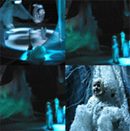
A PlaySpace made of wearable architectural elements
txOom is a responsive PlaySpace, where the participants are invited to actively take part in transforming the environment; shaping the sound, playing with visuals, tangling in textiles, and thereby influencing the audio and visual environment around them by the way they move and interact with the space. The txOom environments "adopt" the properties of living skins. Fabrics, garments and objects in these spaces are shapeable interfaces. [via near near future]
The PlaySpace is composed of several wearable architectural elements including wall-shirts, swing-dresses and floor-skirts. By wearing these garments, the participants literally wear the txOom space, causing the physical environment to be reshaped by their activity in it. This activity influences the shape of the physical environment as a whole, simultaneously inciting growth and mutation in the media worlds. Each player is sensed by the PlaySpace using motion sensors and vision tracking systems incorporated into the space. Gradually, the social interaction between the participants, and the responsive sound and visuals projected throughout the PlaySpace, will change and evolve as they begin to play together.
Posted by jo at 12:00 PM | Comments (0)
Nullpointer

Warped Experiences
CCTEX is based on the expanding cultural practice of game modification and the increasing presence of cctv and mass observation technologies. In CCTEX a level from 'Counter Strike' (a popular counter-terrorism mod) is re-mapped to offer the user an warped experience of covert surveillance.
The environment that the user experiences is coated in imagery drawn from a set of webcams that are positioned strategically around the installation space. Streaming video of the audience and gallery space are translated into textures that paint the modified game architecture. The textures are manipulated during this process to create a semi-abstract reflection of the users' space outside the machine. The viewer is confronted with a distorted vision of themselves and their environment as they interact with the work. [via neural.it]
In a previous work I focussed on the ubiquitous nature of cctv and digital media streams. (Peacekeeper took as its content the already glitched news web broadcasts with their nightvison camera shots and digital artefacts). With CCTEX the data source is drawn directly from the users behaviour and the physical space outside the machine. The increase of covert surveilance (both public and private) is a familiar trend but rarely is the audience of such observation permitted to see their performance onscreen. Not only does CCTEX present the user with their own captured image but it also demonstrates how such data can be distorted and manipulated.

PeaceKeeper: A networked, digital art installation for the Radiator Festival (1-11 May 03). Shown at the Surface Gallery, Nottingham (Commissioned by NOW & Trampolene).
For this project the software application that gamers use will be modified to warp the viewers experience of a frenzied online space. The digital arenas of an online FPS (First Person Shoooter) will be reprocessed into abstract architectural forms, time becomes compressed into a visceral texture.
Within this environment two computer controlled adversaries (Bots) are locked in an endless cycle of killing. Each Bot has only one objective, to eliminate the other, but with each victory the players are reborn to start the process again. The commanding logic behind this loop is inhuman and seemingly irreversable. However the viewer is invited to step within the cycle and intervene in the process. Each Bot will be represented by a large scale projection of its current view, from its own first person perspective. The two projections face each other across the installation space, as if allowing the opposing players to witness their deaths through their enemy's eyes.
Final Score
The installation ran for 10 days (24 hours a day) during the festival. The final score was 4408 v 2204. Bots were initially evenly matched but over an extended period small differences in their behaviour effected the final outcome.
Posted by jo at 10:24 AM | Comments (0)
Public Genitals Project
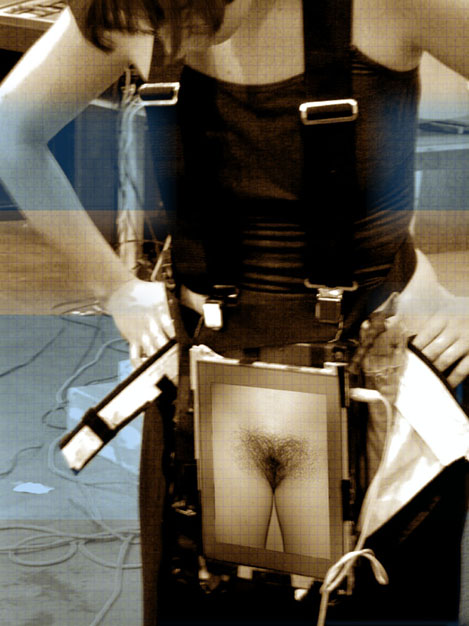
Not Safe for Walks
The Public Genitals Project , by Sandy Stone, playfully questions the boundaries between inside and outside, revealed and hidden, representation and reality.
Each PGP unit consists of a video broadcast receiver, battery pack, two small loudspeakers, and two modified laptop computers worn by a person walking the streets of Austin.
In one version, the person is naked except for the screens, which are attached to suspenders and worn so they cover the genital areas front and back. In the second version the person is fully clothed except for cutouts over the genital areas front and back, within which the two screens are mounted.
In operation, participants worldwide send images of their genital areas via webcams. The images are digitally manipulated according to an algorithm driven by the number of times the words "sex" and "violence" appear on the webpages of CNN, MSNBC, and CBS. The digital manipulation smooths and abstracts the images; the more the terms "sex" and "violence" appears in the media, the more that actual body images recede toward imagined recollections. The images are then broadcast and displayed on the flat screens. Concurrently, the loudspeakers present ethnographically recorded narratives of personal experiences with nudity, shyness, and desire, which are stored as sound files on the computers. The juxtaposition of images and physical body surface is meant to convey the illusion that the viewer is looking through a transparent electronic window at the surface of the wearer's body.
In reality, no actual flesh-and-blood genitalia are directly visible, and no explicit representation of individual genitalia is shown, though it is likely that this distinction may be lost on the naive viewer -- we hope. (Posted by Régine Debatty)
Posted by Regine at 09:19 AM | Comments (0)
January 09, 2005
Three by Thomas Charveriat

Animatronic Installations
The Machine Manifesto is an interactive musical performance that reflects upon the relationship between human beings and machines. It is composed of a series of mechanical musical instruments or automatons, and directed by an orchestral conductor. The instruments--programmed to perform independent tasks--follow the commands sent by the conductor via image recognition software. Machine Manifesto reflects the existing asymmetry between humans and machines (conductor and instruments), and provides an ironic look on the privileged position of machines in our society.
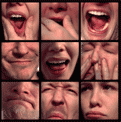
Light Activated Faces: A torch flashed at a square panel standing vertically on the floor, produces the sound of human onomatopoeias which vary depending on the area onto which the light is projected. Nine different grimaces are depicted on this photographic panel. Each facial expression becomes visible by means of a light box mechanism, whenever the flashlight points at it. A corresponding onomatopoeia is then produced by a sound sampler. The effect is a large human chorus conducted by the action of a flashlight.
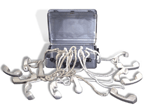
Telephones: Artificial intelligence is a rapidly developing area of scientific research. Many jobs formerly held by humans are now being done by computers, often by "bots" (computer generated intelligent entities that present themselves as human in order to perform tasks for others). One field where this has become common is automated phone service. This piece illustrates the computer's potential by replacing live person on a sex phone line with voices created by a computer. In it, twelve different computer-generated personalities have intimate conversations.
Thomas Charveriat (Paris, 1974) lives and works in Barcelona, Spain. Studied photography at the School of Visual Arts(SVA)and afterwards obtained a master degree in sculpture from Columbia University. Both schools are located in New York City. After finishing his studies in New York, he moved to Barcelona, where he obtained a master degree in digital arts at the Pompeu Fabra University. He has won a number of scholarships and prizes. He has participated in collective art exhibitions in New York, Paris and Barcelona since 1998. At the moment, Thomas Charveriat creates animatronic installations with GPS, SMS, video, sound, electronic data and humor that interact with the viewer in a peculiar environment, where the complexity and elegance are combined to create sensorial ambiguity associated with an atmosphere of vulnerability and apprehension.
Posted by jo at 11:59 AM
UpStage Open Walk-Through
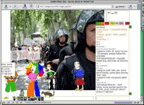
Be UpStaged!
The next UpStage open walk-through will be on Wednesday January 12, 2005 at the following times: 1am California; 4am New York; 9am UK; 11am Finland; 8pm Sydney; 10pm New Zealand. Check your local time.
2004 was the full first year for UpStage: the first version of the software was launched on 9 January and immediately put to work in the World X project, a schools exchange between Aotearoa/NZ and the UK. In May, the first cyberformance using UpStage, "DTN2" was presented by Avatar Body Collision at the Machinista Festival, Glasgow. Zagreb Gay Pride participants used UpStage in June to give an online presentation about their march, and it was also used for presentation purposes at the /etc festival in Belgrade in July. In October a one-day online workshop was held for participants in Manchester, UK, with the tutor in Aotearoa NZ. There were several other workshops and presentations during the year - more information and links to various projects are on the web site.
A significant event in December 2004 was the relocation of the UpStage server from MediaLab South Pacific, who kindly provided hosting during the development of the project, to our new sponsors CityLink. As we don't have any funding at the moment, finding a hosting sponsor was vital and we greatly appreciate CityLink coming on board without hesitation. Thanks! : )
Regular open walk-throughs began in October, on the first Wednesday of each month, and many of you have taken the opportunity to have a hands-on experience of UpStage. Everyone needed a bit of a break by the end of the year so the first walk-through for 2005 is taking place on the second Wednesday, which is the 12th - times above or see http://upstage.org.nz:8081. Please email helen @ creative-catalyst.com to register (the upstage email addresses haven't quite got hooked up properly since the server shift...you can't have everything all at once!).
We're enjoying the slower pace of the holiday season, so plans for 2005 are still formulating; we won't make any promises yet but we will keep you posted... meanwhile we wish you a peaceful and creative 2005 and hope to see you at the walk-through on the 12th or in the near future.
helen : ) (helen varley jamieson)
Posted by jo at 11:41 AM | Comments (0)
January 07, 2005
LifeLine
""...Traditionally, the performing arts is comprised of three components - the performer, the audience, the stage. The performer engages the attention of the audience; the audience observes and responds to the gesture and prose articulated by the performer; the stage provides a formal structure within which the relationship between performer and audience is cultivated and sustained. Separation from the creative process is perpetuated whilst the stage imposes its own criteria upon it." 1.
The hierarchical performance space described above is posited on notions of authorship, in the modern history of cinema and theatre first the writer, then the text and finally the context have all laid claim the authority of meaning. New forms of performance especially interactive forms rely on a more democratic distribution of authorship that occurs when the performance space no longer relies on the separation of author and audience but engenders an integrated space, a space shared by both the performer and the audience that disperses authority." from The Extended Logic of the Interactive Performance Space by Gregor White.
Posted by jo at 05:29 PM | Comments (0)
Traces of Fire
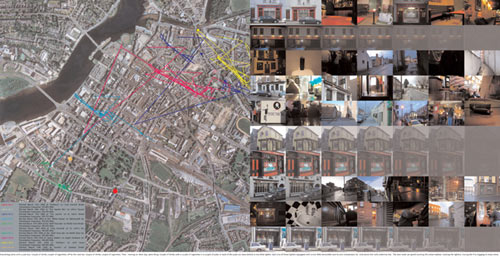
Tracking the lighters
Volkmar Klien & Ed Lear's Traces of Fire was a social experiment that traced the movements of ten cigarette lighters tagged with transmitters to provide location and motion data frequencies.
The artists 'lost' the lighters in pubs in Limerick and observed during two weeks how they were carried around town by unknown people. From the cumulative data, the artists built a series of exhibitions showing patterns in the locations and movements of the lighters around the city.
Tracking the lighters and collecting position data was achieved with the help of transmitters normally used as animal implants in wildlife habitat studies.
Via Urban Habitat Research. (Posted by Régine Debatty)
Posted by Regine at 12:53 PM | Comments (0)
January 06, 2005
Special Treatment
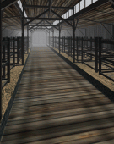
Memory as Malleable Substance
Special Treatment advances the audience from passive viewing to active experience by smoothly moving from present to past and back again. Special Treatment creates a landscape where glimpses and fragments of Birkenau establish a narrative framework where the events of the past continue to shape and be shaped by contemporary interpretations of those events. The full history and lesson of a place such as the death camp at Birkenau is seen not only in the records of those who survived or passed on their memories to us in the present, but in how those events are remembered and shaped by the people of today. The stories of these people grow with each new experience of Special Treatment, and the solidity of that space and the substance of those events becomes more concrete with each new visitor. The immersive experience allows each participant to inhabit the scene of these events, and as they leave the evidence of their own actions and memories, Special Treatment is continually transformed into a new potential memory. [via Rhizome]
At its most basic level, memory is a perceived arrangement of events. Applied Interactives is concerned with how memory is a malleable substance, and Special Treatment's poignancy is highlighted by a world where global and mass communications instantaneously influence impressions of events, so that people have incomplete or greatly divergent ideas about the same occurrences. Even if we tried to faithfully recreate the past, the interpretation of those events would vary from one day to the next.
Although Special Treatment uses the holocaust as a context, the project creates an experience beyond time by focusing on the larger issues of persistence and memory. Events other than the holocaust could have been used as the basis for Special Treatment. However, any occurrence that exhibits the tragedy of 'history repeating itself' provides a powerful framework for taking a critical look at how and what people remember, how they change their thoughts over time and how cultural biases influence personal recollection.
Not a "virtual reality" but an interpreted reality, Applied Interactives has specifically selected our medium to fully engross participants in the experience by allowing them to create their own personal narrative. Special Treatment is more than observation - the piece is interactive as well as reactive; visceral and emotional as well as intellectual. The term virtual reality, as a cliché of futurist propaganda, has been overstated by the media and is widely considered to be an attainable technology. We are critical of this belief and the entertainment industry's portrayal of interactive storytelling. We find that they more commonly wish to construct their stories with products and brands rather than use the medium in the creation of a meaningful experience. Other meda are bound to formulaic standards that utilize obvious narrative arcs that don't allow for the same degree of individual ownership of the experience. With Special Treatment we hope to break down the conceptual barriers that have been placed around artwork employing these cutting-edge technologies.
Applied Interactives is an artist-based 501(c)(3) non-profit organization founded in Chicago in 2001. Its primary mission is to propagate virtual reality technologies and art into the exhibition spaces of galleries and contemporary art museums as well as into the hands of individual artists. AI is composed of students, faculty, and alumni of the University of Illinois at Chicago (UIC), Columbia College Chicago and The School of the Art Institute of Chicago (SAIC).
Posted by jo at 10:46 AM | Comments (0)
Some time of available human brain
![dtdchd1[1].jpg](http://www.turbulence.org/blog/images/dtdchd1[1].jpg)
Internet installation for television channel
and computer assisted actor
"Some time of available human brain" is a ten to fifteen minute performance conceived by Christophe Bruno.
An actor lies on a psychoanalyst's couch, with a television that broadcasts a TV channel live behind his back. Behind the couch, a person types in key words in relation with what the TV set shows. These key words are sent on a server and thanks to a search engine, a program extracts the textual flood relating to the chosen key words in real-time.
The text is then read by a voice synthetizer and sent to the headset of the actor who says it as soon as he hears it.
The result is a two-voice performance: the voice of television--the spectacle provider--and the voice of the Web, where a fallacious freedom masks the success of the society of control. (Posted by Régine Debatty)
Posted by Regine at 03:57 AM | Comments (0)
January 05, 2005
Habitgram

Cloaked in Space
Habitgram, by Montreal-based artist Beewoo, is a surveillance coat that the visitor is invited to wear. Inside the coat, several wireless mini-cameras pick up the environment of the wearer. The images are multiplied through video projections on the space walls. While wearing the Habitgram, the participant actually "wears" the space in which (s)he is standing.
As the cameras are positioned so as to rotate the captured images, either vertically, horizontally or at a 90° angle, some participants tried to restore the images to their original position and many others reported experiencing sensations of vertigo while wearing it.
"The user in command of this mediated image flow finds himself submerged in it in a discomforting way. Would the media image be so untamable? Drowning in this immersive environment, the viewer constantly attempts to understand its structure and source. Meanwhile, (s)he discovers new ways of exploring the physical architectural space in relation to its multiplied video mirror. Here, being immersed does not prevent the viewer from taking a critical distance towards the artwork. On the contrary, it is the immersion itself that triggers critical observation." [from near near future]
Posted by jo at 10:33 AM | Comments (0)
VisitorVille
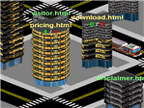
Website Traffic Statistics Visualization Software
VisitorVille is software that takes a new visual approach to web analytics; instead of representing website visitors simply as numbers or graphs, it displays them as real people in a real environment. You can watch your site traffic as if you were people-watching in a big city. VisitorVille brings your website visitors to life as animated characters in real time. [via neural.it]
Posted by jo at 10:07 AM | Comments (0)
Fools Paradise

An Island Floating in a Sea of Stars
Fools Paradise is a VR installation and performance created by artist Paul Hertz and composer Stephen Dembski, based on the "Proverbs of Hell" by visionary poet and artist William Blake. It is also an intermedia work, where different sensory modalities share underlying structures. The artists developed musical structure and visual structure in collaboration. Dembski scored forty-eight proverbs for soprano, cello, and flute. Hertz created a landscape of colorful gems embedded in a tableland on an island floating in a sea of stars. Seen from afar, the island resembles a tongue, the tableland a book. With a clamor of children's voices, a stream of words runs down the central crease of the tableland and cascades over a cliff onto the tip of the tongue and into the sea. The VR performer visits each gem, triggering a song and a mask as she goes. The current mask floats in front of her, and also replaces the gem, until the island is filled with masks, all facing the VR performer. [via Rhizome]
Paul Hertz (paul-hertz @ northwestern.edu) makes art in both digital and traditional media. He has worked in various positions at Northwestern University. In 2003—04 he was Co-Director of the Center for Art and Technology. As a Visiting Artist in 2001 and 2002, he taught the university’s first course in virtual reality for artists. He also developed and taught a course in Interactive Multimedia from 1999–2003. A grant from Northwestern’s Center for Interdisciplinary Research in the Arts helped him to develop VR performance artworks and software. With the support of the journal Leonardo, Hertz is curating an exhibition of pioneering computer graphics for the Block Museum at Northwestern University, for April 2006. He supports his art habit with a day job designing networked multimedia applications for the Collaboratory Project at Northwestern University, where he is currently working with a terabyte astronomical database in a project funded by the National Science Foundation.
Hertz spent many years in Spain producing paintings, music, and intermedia performance works. He earned an MFA at the School of the Art Institute of Chicago, where he began to create digital intermedia art as a fellow of the Center for Advanced Studies in Art and Technology. See http://www.northwestern.edu/people/paul-hertz for links to Hertz's portfolio and other materials.
Posted by jo at 09:02 AM | Comments (0)
The Crossroad
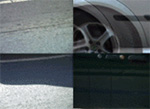
Music at Traffic Lights
The Crossroad -, a quadrophonic installation created by Tomas Dvorak alias Floex, generates music from the colours of cars which meet on the crossroad. As cars pass by they create impulses which carry the information equal to music like tone and interval, rhytm, structure.
Cameras shoot and sample colours of the cars on 4 places before traffic lights. Visual information is sent to computer which analyzes the data.
The work is based also on prerecorded samples and loops composed by a program operating on data from the crossroad, so the artist doesn't create the final form of the composition, but he also doesn't let the computer create all the data randomly.
One of the key concepts of this work is that some kind of everyday phenomenon could operate artistic process. From this point of the view this work could be taken as a search for the codes of art in the ordinary reality. (Posted by Régine Debatty)
Posted by Regine at 02:18 AM | Comments (0)
January 04, 2005
Dry Translator
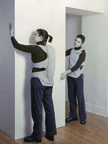
Walls as Touch Messaging Devices
Dry Translator, a sculptural installation piece by Sabrina Raaf, is built in response to new trends in 'smart architecture.' Smart technology is being created for enhanced human interaction and control of one’s urban building and home environments. Interestingly what excites many is not the necessarily the enhancement of control, but really more the idea of intelligent responsiveness and heightened personal connection with the rooms they inhabit.
Dry Translator is taking this idea of responsiveness to an exaggerated degree. The idea is to create an environment so sensitive to human presence that a touch to its walls sends resonant vibrations throughout the bodies of its occupants. Whereas normally people acknowledge the presence of walls in a building as merely types of boundaries or surfaces, this piece allows them to engage with walls in newly intimate ways such as touching, beating, and even 'playing' the walls as instruments. And, it also allows them to use the walls as sorts of touch messaging devices.
The piece includes two custom designed audio vests (which gallery visitors are invited to put on) and an interactive wall. Essentially what occurs with this piece is that when a participant touches the wall in the gallery, they hear the sound of their touch not locally where their fingers hit the wall, but actually on their own torso (via the vest). Inside of the wall there are several wired tentacles that act like stethoscopes which are able to pick up the slightest vibrations within the drywall material. Sounds from participants touching the wall are greatly amplified and transmitted wirelessly to the vests. The wall becomes a skin-like extension of the participant’s own body. In touching the wall, they touch their self. Participants may also record a series of touches or gestures on the wall via an interactive consol and thereby leave a message for the next participant to play back on the vest.
Posted by jo at 08:01 AM | Comments (0)
Alter Ego
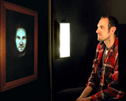
A mirror that frowns back at you
Alf Linney, a specialist in facial reconstruction, and artist Alexa Wright have designed Alter Ego which allows people to interact with a ‘mirror’ that takes on a life of its own.
Sitting in front of it, the viewer is captured on video and the dimensions of their face are mapped onto a generic model (with a simplified version of the technology Linney uses for surgery). After some 30 seconds, the ‘reflection’ begins to react to the person's facial expressions. "We can make the model do whatever the person in front of it is doing – smile or laugh – or we can give it an alter ego, a sort of a mind of its own", explains Linney.
The mirror won’t do what the user necessarily expects. For example, the mirror can shock smiling people by suddenly frowning back at them.
More mirrors: persuasive mirror, MirrorSpace. [blogged by Regine on near near future]
Posted by jo at 07:55 AM | Comments (0)
Saturday
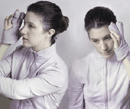
Sounds Mixed in the Bones of the Listener
"With the overuse of radio frequency bands for wireless communications, there comes the increased occurrence of crossed lines where a private conversation becomes accidentally shared. To create this interactive sound piece, Saturday, [Sabrina Raaf] used walkie talkies, CB radios, and various other forms of consumer spy (or ‘security’) technology in order to actively harvest such communication leaks. Saturday forms a uniquely intimate portrait of the community of Humboldt Park, Chicago through a composite presentation of conversations stolen on Saturdays in the park. Saturday is a sound based artwork that participants experience through a custom designed glove interface. [via near near future]
When I began working with wireless sound technology, I was startled by the sheer quantity of non-phone, low tech, radio transmissions that were constantly being sent around my neighborhood. Humboldt Park is a lower income, racially mixed neighborhood of Chicago. The transmissions included communications between gang members on street corners nearby and group conversations between friends talking about changes in the neighborhood and their families. There were raw, intimate conversations and often even late night sex talk between potential lovers. There is a furtive quality to most of these conversations and also a particular daringness in their tone. During the series of Saturdays, I also recorded the sounds of my neighborhood – the women singing out their windows to their radios, the young men in their low rider cars circling the block, the children, the ice cream carts, etc. These are the sounds that are mixed in the piece. And, these are the sounds that literally drip from participant’s fingertips in Saturday.
Saturday is presented in the form of an interactive glove. In order to hear the audio, participants magically just press their fingertips to their forehead and they hear the sound without the use of their ears. The glove is outfitted with leading edge audio electronic devices called “bone transducers” which make this possible. These transducers transmit sound in a very unusual fashion. They translate sound into vibration patterns which resonate through bone. This is the same process as the natural hammer and anvil system inside our inner ears which allows us to perceive sound. Since the bone transducer does all this work artificially, it allows you to hear crisp audio without it being played out loud or through headphones. So, even if a user covered their ears and then placed their fingers to their temples, they still ‘hear’ the sound. No sound at all is heard by anyone but the participant at any time. This piece permits a new way of listening. The user places their fingers to their forehead – in a gesture akin to Rodin’s The Thinker or of a clairvoyant – in order to tap into the lives of strangers. Pressing different combinations of fingers to the temple yield plural viewpoints and group conversations. These sounds are literally mixed in the bones of the listener."
Posted by jo at 07:50 AM | Comments (0)
Historical Summary
What We Learned
Exactly when is the "live" performance of the pre-recorded video presentation? What space is the artist occupying, the loft or the circulatory system of the Internet itself? Live "chat" was being received by the Pseudo chat jockey from viewers around the world. After the "live" show was performed, the streaming video image was saved on Pseudo's server for six months. This event could subsequently be viewed "on demand" from any point on the globe with a live Internet connection for as little or as long a time as the viewer chose, adding yet another dimension to time and space as embodied by art on the Internet. Read Martha Wilson's essay.
Posted by jo at 07:04 AM | Comments (0)
January 03, 2005
Real time 3D

3D tools for performance artists
Touch Tools by Derivative, Inc. is a software toolkit that allows performance artists, VJs, architects, musicians, stage designers, and others to create 3D visuals in real time.
Using Academy Award-winning technology as its' basis, Touch is infinitely customizable. Creating your work in Touch is accomplished with visual, node-based editing, and Touch Designer has capabilities to create procedural 3D models, particles, compositing, textures, and live video input.
Touch tools have already been used in high-profile projects, such as the visuals and other controls for Plastikman shows and as part of the new Prada building in Tokyo.
I used an earlier version of Touch Designer to create Immaterial, a performance of live 3D elements with pre-recorded video. (Posted by Michelle Kasprzak)
Posted by at 01:11 PM | Comments (0)
Portable Cellular Phone Booth
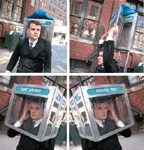
Sacrificed Interaction
"The Portable Cellular Phone Booth provides a visual image of social sacrifices and opportunities to interact with one another lost due to our own self -involvement. The sculpture is a retractable phone booth that is carried on your back and can slide up and over your head to completely isolate you from society, kind of like the way a cell phone does. The action is fast and slick just like the flip action of a cell phone.
Historically the iconic phone booth represented a place where one could go to be alone for a private conversation, transform into superman or travel through time. Today, it's obsolete in most cities. With the Portable Cellular Phone Booth, one can transform from a member of society to one that is closed off.
By delivering my sculpture to an unsuspecting public, anyone who notices the piece receives a myriad of messages from self deprecating humor to the neglecting of friendship in real time for the hope of something better." --Nick Rodrigues, from an interview on Sensory Impact. [via textually.org]
Posted by jo at 11:30 AM | Comments (0)
LUCY ORTA

The Staging of a Social Bond
LUCY ORTA born in Great Britain 1966, studio based in Paris. Lucy Orta's Refuge Wear, was first noticed in the early 90's. These objects resembled temporary mobile architectures which transformed into poetic items of clothing, sleeping bags, first aid units, for nomadic populations. Her Collective Wear sculptures in the form of tent domes with protruding appendages, exhibited in the Modern Art museum in Paris in 1994 were placed into urban contexts for a series of interventions in housing estates, subway stations... and later developed into a human chain, Nexus Architecture which has since become the emblem of her work and has been presented in site specific performances such as the Venice Biennale in 1995, Johannesburg Biennale 1997, Museum of Contemporary Art Sydney 1998, Bolivia, Berlin, New York, Mexico City.
She encourgages in an active participation from very diverse members of the community by organising workshop "Actions" and her projects both in the museum space and within the community question the role of art as a agent for participation and dialogue. Particulary pertinent are the public works Life Nexus Village Fête co-comissioned by the University of Central England for the exhibition "In the Midst of Things" in Bournville 1999 and the Art Gallery of Western Australia 2000. Recent public works such as "Hortireycycling Enterprise" exhibited at the Secession in 1999 and 70x7 The Meal introduce the theme of the meal as a ritual for public exchange and at the Kunstraum Innsbruck in January 2000, she proposed a 70 metre table service with a series of lunches for infinite number of guests to dine together for a moment of convivialty.
"The staging of a social bond is the common denominator linking Lucy Orta's different projects and perfectly reflects her transverse approach to poetic expression. Her Refuge Wear and Nexus Architecture interventions are effective tools in the struggle against exclusion and combine architecture, body art, street theatre, fashion, social therapy, formal poetry and ideological activism. The titles of her principal projects, which function both as social scenarios and art works, speak for themselves : Nexus Architecture, Refuge Wear, Modular Architecture, Commune Communicate, Citizen Platform... She has, since 1992, brilliantly addressed issues of relational aesthetics, her principal field of intervention being the personal space of the individual fighting for survival in adverse conditions." Pierre Restany [thanks pasta and vinegar]
Posted by jo at 10:52 AM | Comments (0)
Welcome To The Jungle
"Unitary Urbanism envisages the urban environment as the terrain of participatory games. We are thus able to envisage making use of the climatic conditions in which two major architectural civilizations arose -- in Cambodia and in southwest Mexico -- in order to construct moving cities in the jungle.
The new neighborhoods of such a city could be constructed increasingly toward the west (which would be gradually reclaimed as one goes along), while to the same extent the east would be abandoned to the overgrowth of topical vegetation, thereby creating, on its own, zones of gradual transition between the modern city and wild nature. This city, pursued by the forest, would offer unsurpassable zones of derive that would take shape behind it.
We are only at the beginning of urban civilization; it is up to us to bring it about ourselves. Digital Unitary Urbanism maintains an interest in technology as a means of evoking a new kind of urbanism characterized by the ability of individuals and social groups to appropriate and co-create urban space. Technological products and systems by no means have to be developed with pre-defined goals or use patterns in mind. DUU encourages ‘bottom-up’ technological manifestations in which individuals rather than institutions define content, use and structure."
Originally blogged on FishArePeopleToo. The Digital Unitary Urbanism presentation is here.
Posted by jo at 10:27 AM | Comments (0)
Record_
![]()
Virtual-Sound-City
Record_ by Alberto Guedea: _pre-recorded audio from computer hardware manipulations [using hardware as musical instruments] processed and de-constructed live, digitally_"For this venue I will be studying the idea of a virtual-sound-city by recording audio pieces, utilizing computer hardware as the only physical 'musical instruments' to produce the recorded sound. These recordings of hardware manipulations will be processed afterwards through various popular music software engines in a series of long length private and public performances which will be webcast in real time, through the Reverie server during January 2005.
The webcast performances will be abstract net-installations of audio and they will be focused primarily on the concept idea rather than on schematic or structured musical compositions. These sound installations and audio investigations will address virtual reality in present times."
Posted by jo at 08:21 AM | Comments (0)
MuSE

Multiple Streaming Engine
MuSE provides the free software community with a user friendly but powerful tool for network audio streaming, making life easier for indypendent free speech online radios.
MuSE is an application for the mixing, encoding, and network streaming of sound: it can mix up to 6 encoded audio bitstreams (from files or network, mp3 or ogg) plus a souncard input signal, the resulting stream can be played locally on the sound card and/or encoded at different bitrates, recorded to harddisk and/or streamed to the net. When sent to a server, the resulting audio can be listened thru the net by a vast number of players available on different operating systems.
To be operated MuSE offers graphical interfaces and a documented commandline interface in the good old unix style. MuSE is free software and it is released open source under the terms of the GNU General Public License.
Posted by jo at 08:07 AM | Comments (0)
January 01, 2005
Biofeedback for Two

A co-operative experience
Pas de Deux by Mary Lucking is a performative installation for two people. The participants wear biofeedback devices and must co-operate by regulating their breathing to create patterns and align projected circles on the gallery wall.
When we think of performance, we tend to think of disciplines that are directly related - theatre, dance, etc. Pas de Deux reminds us that even very fundamental actions, such as breathing, can be measured in a performative sense, and that in many ways, we are all performers. (Posted by Michelle Kasprzak)
Posted by at 04:13 PM | Comments (0)
Go ahead, scream

Wearable body organs
ScreamBody is a "wearable body organ" by Kelly Dobson. The ScreamBody device permits wearers to indulge their impulse to scream, even in inappropriate places, by acting as a silencing vessel. The device also records your screams, and will play them back for you at a time that you determine.
This device cleverly exploits notions of appropriate behaviour and impulse. It is a whimsical device, providing a very specific purpose for public situations. It also comments on trends in device design, where some devices are incredibly specific (as ScreamBody is), contrasting with other devices that are meant to do everything except make your toast in the morning (such as some advanced PDAs), though they often are used for a singular feature that has the most relevant function. (Posted by Michelle Kasprzak)
Posted by at 04:09 PM | Comments (0)
